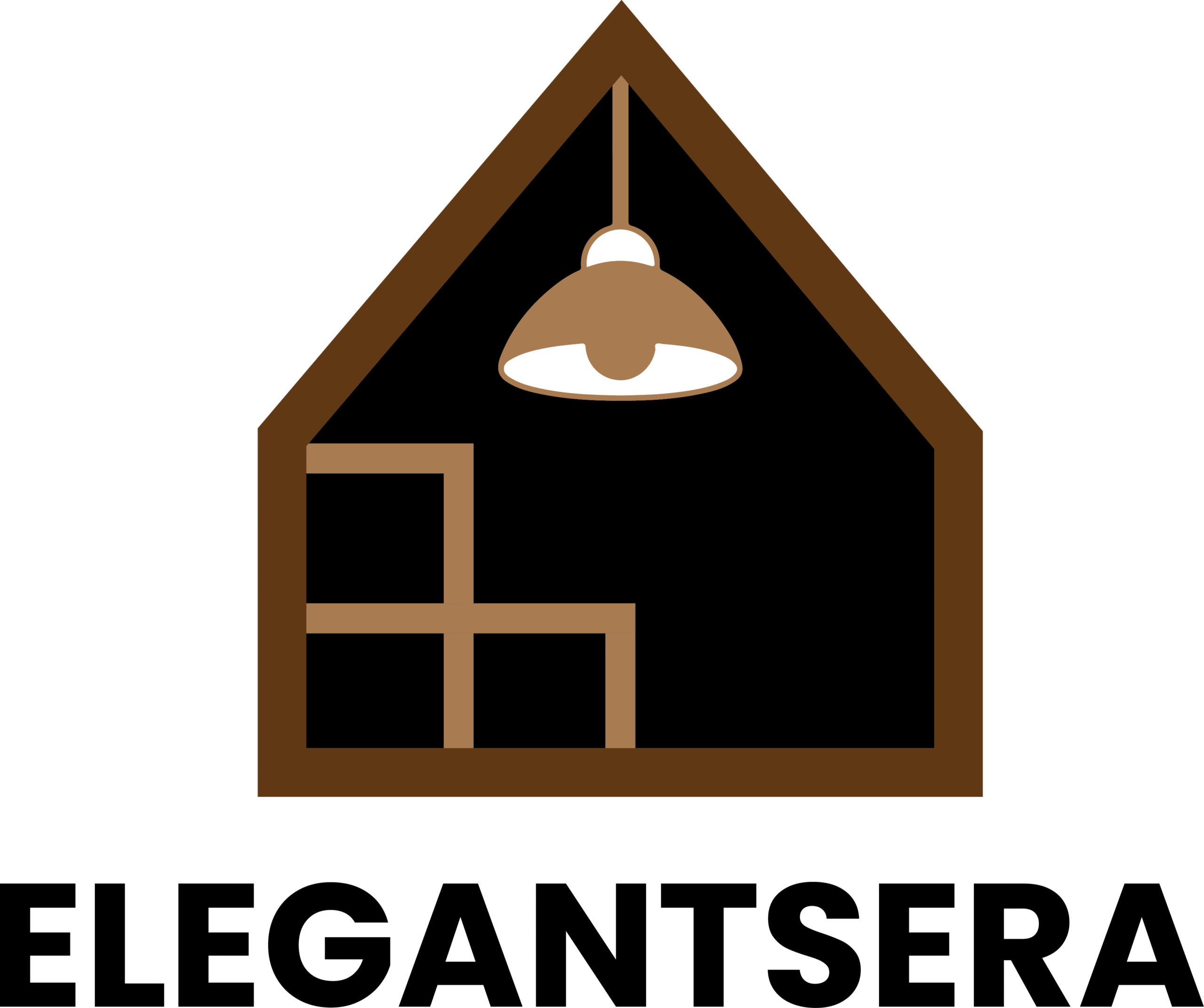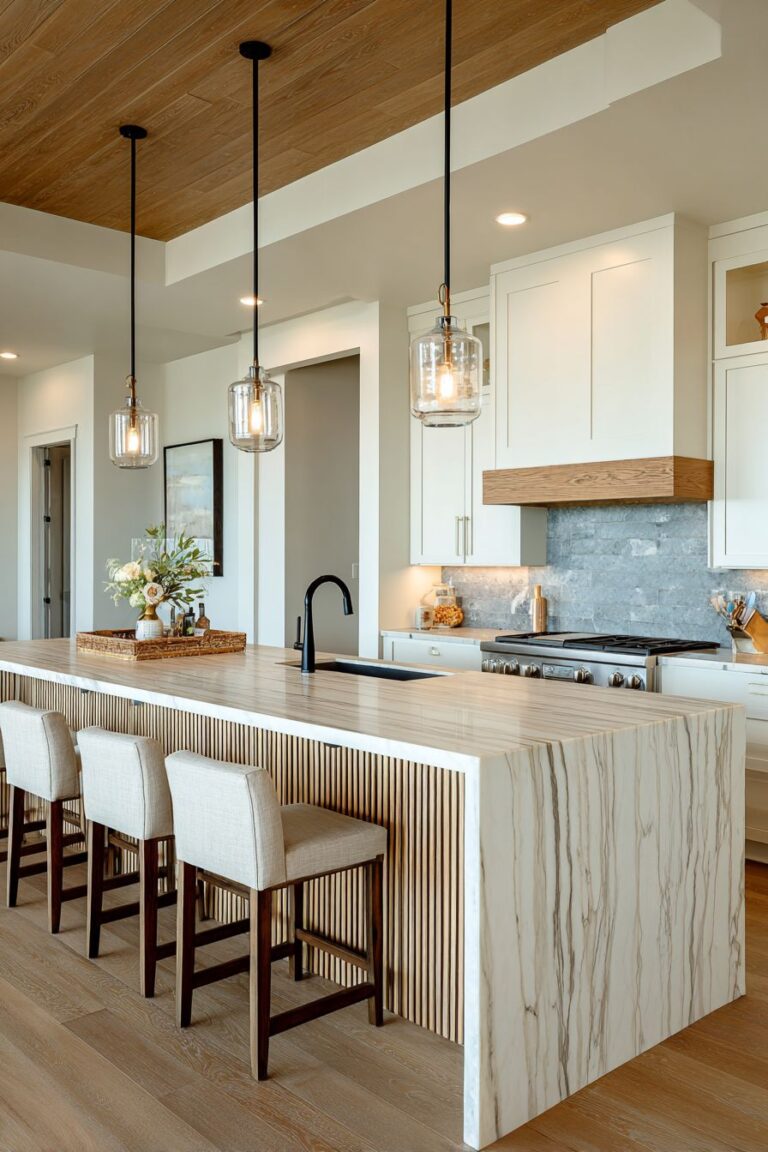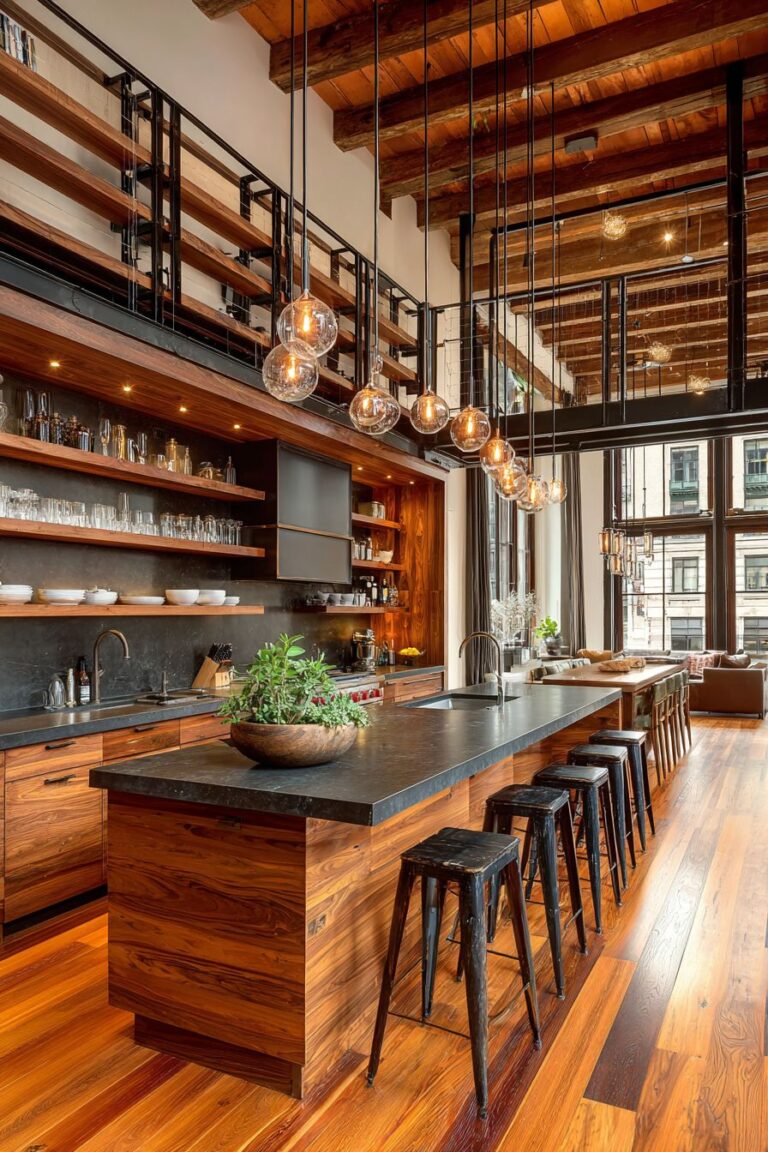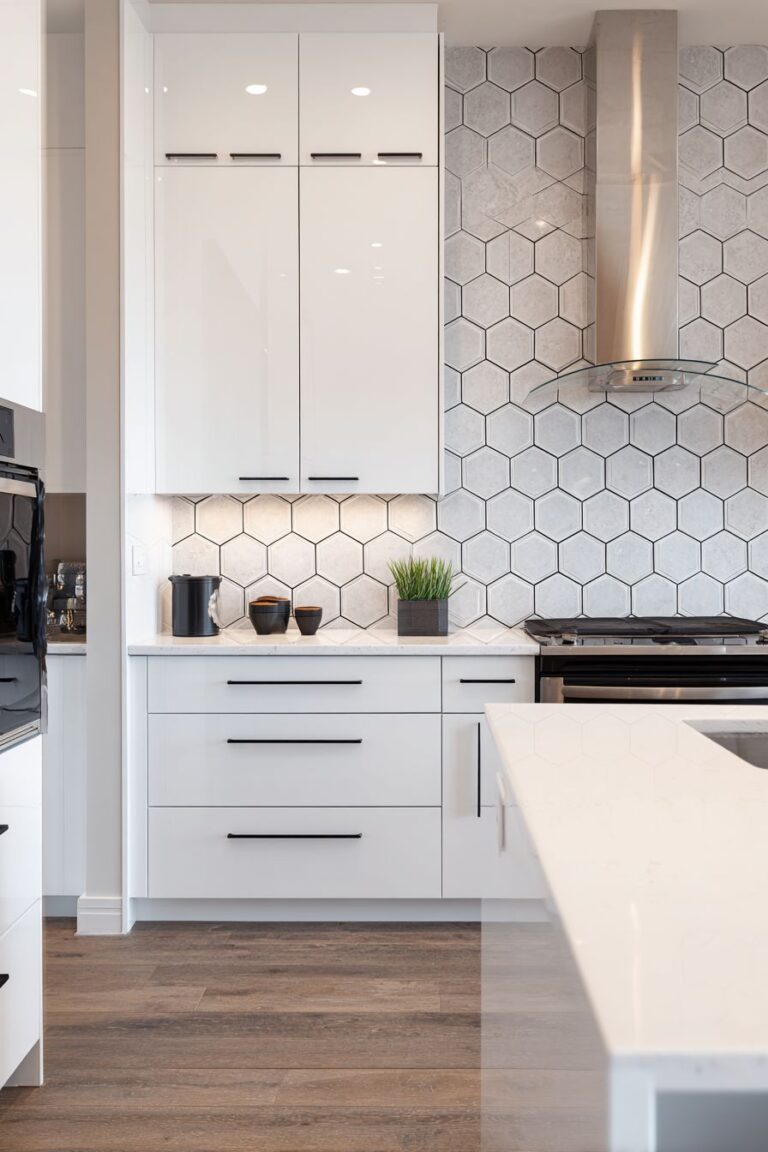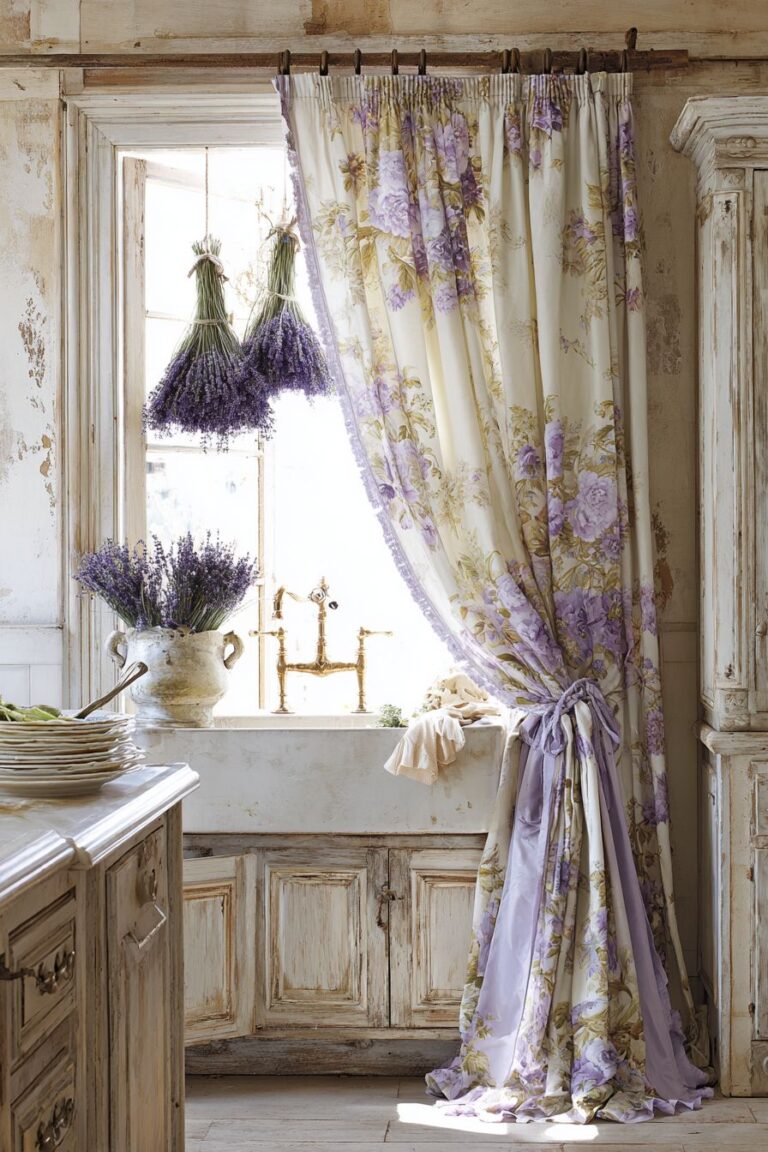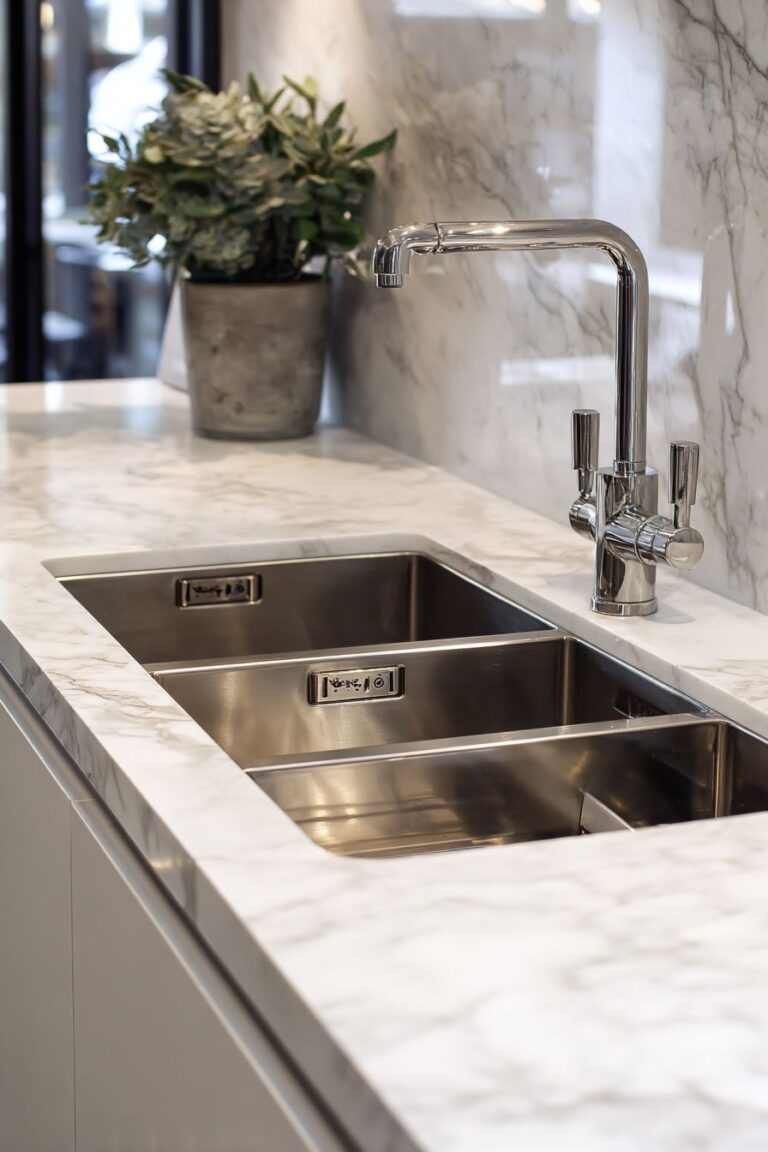20 Stylish Red Kitchen Decor Ideas To Warm Your Home
The kitchen stands as the heart of every home, where culinary creativity meets daily functionality, and where families gather to share meals and create lasting memories. In the realm of interior design, few colors command attention and evoke emotion quite like red. This bold, passionate hue has the remarkable ability to transform ordinary kitchens into extraordinary spaces that pulse with energy and warmth. Red kitchen decor represents more than just a color choice—it’s a statement of confidence, a celebration of boldness, and an invitation to embrace the vibrant essence of life itself.
From the sophisticated elegance of cherry red lacquered cabinets to the rustic charm of distressed burgundy farmhouse elements, red offers an extensive palette of possibilities for the discerning homeowner. Whether you’re drawn to the industrial edge of exposed red brick walls or the timeless appeal of vintage red appliances reminiscent of the 1950s, this versatile color adapts seamlessly to virtually every design style. The beauty of incorporating red into kitchen design lies in its ability to serve multiple roles—as a dramatic focal point, a warm accent, or a cohesive design element that ties together various materials and textures.
This comprehensive exploration will guide you through twenty distinctive red kitchen decor concepts, each offering unique approaches to integrating this powerful color into your culinary space. From modern minimalist interpretations to traditional farmhouse aesthetics, from small apartment solutions to grand Mediterranean-inspired designs, these ideas demonstrate the incredible versatility and timeless appeal of red in kitchen design. Prepare to discover how strategic color placement, thoughtful material selection, and expert design principles can transform your kitchen into a space that’s both functionally superior and visually spectacular.
1. Modern Cherry Red Lacquered Elegance
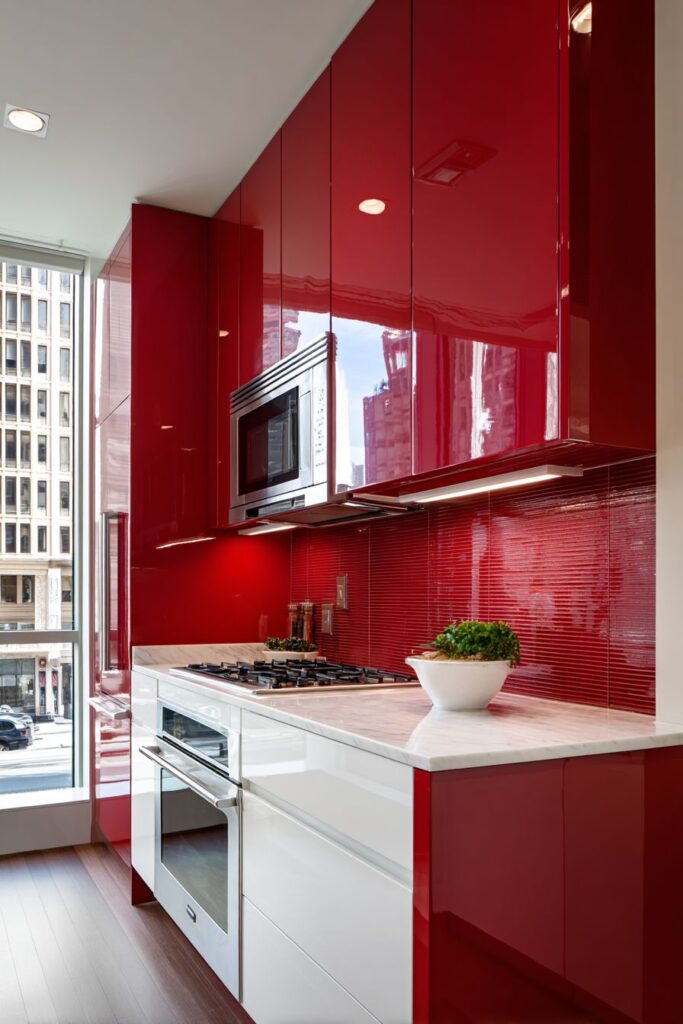
Step into a world where contemporary sophistication meets bold color choices in this stunning modern red kitchen design. The focal point of this space lies in the sleek cherry red lacquered upper cabinets that create an immediate visual impact while maintaining an air of refined elegance. These glossy surfaces reflect natural light beautifully, creating depth and dimension that makes the kitchen feel both intimate and expansive. The strategic pairing with white lower cabinets creates a perfect balance, preventing the red from overwhelming the space while maintaining the bold statement that makes this design so captivating.
The white quartz waterfall countertop serves as both a functional workspace and a sculptural element that anchors the design. This continuous surface flows seamlessly from the horizontal counter to the vertical edge, creating clean lines that epitomize modern design principles. The stainless steel appliances provide the perfect neutral complement, their reflective surfaces echoing the glossy finish of the red cabinets while maintaining the contemporary aesthetic. The red glass tile backsplash adds another layer of sophistication, its translucent quality allowing light to penetrate and reflect, creating a luminous backdrop for culinary activities.
The careful consideration of lighting in this design cannot be overstated. Large windows flood the space with natural light, which interacts beautifully with the various red surfaces throughout the day, creating an ever-changing palette of cherry and crimson tones. Professional lighting design ensures that artificial illumination complements these natural changes, maintaining the kitchen’s dramatic appeal even during evening hours. The result is a space that feels both cutting-edge contemporary and timelessly elegant.
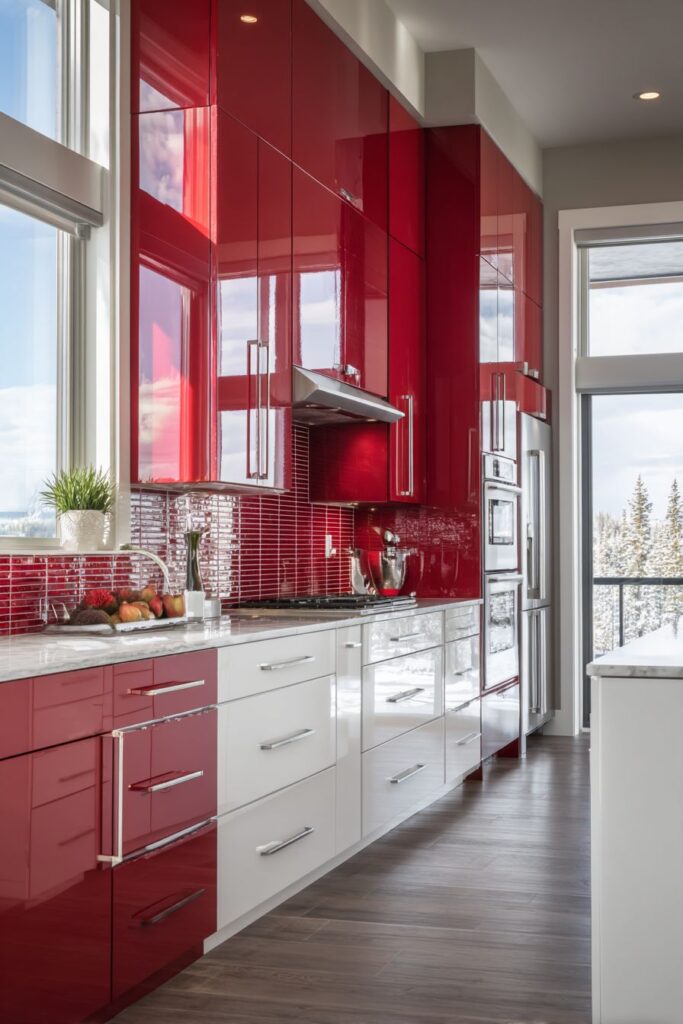
Key Design Tips:
- Choose high-gloss finishes for red cabinets to maximize light reflection and create visual depth
- Balance bold red elements with neutral whites and metallics to prevent color overwhelm
- Incorporate multiple red tones through different materials (paint, glass, stone) for a cohesive yet varied palette
- Ensure adequate natural lighting to showcase the true beauty of red surfaces throughout the day
- Select appliances in neutral finishes that complement rather than compete with the red elements
2. Farmhouse Burgundy Charm
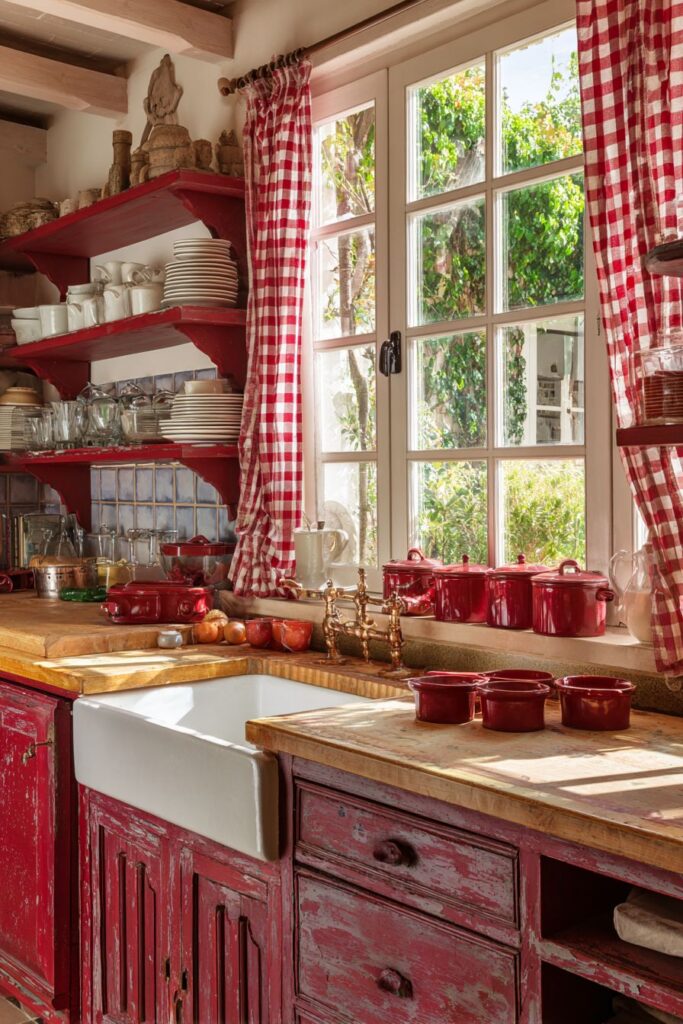
Embrace the warmth and authenticity of country living with this enchanting farmhouse red kitchen that celebrates the beauty of imperfection and the charm of lived-in spaces. The distressed burgundy painted lower cabinets serve as the foundation of this design, their weathered finish telling stories of family gatherings and home-cooked meals shared across generations. This deep, rich burgundy tone evokes the comfort of autumn evenings and harvest celebrations, creating an immediate sense of welcome and belonging that defines the farmhouse aesthetic.
The open shelving above the lower cabinets showcases the practical beauty of everyday dishes, with white ceramic pieces and gleaming copper pots creating a display that’s both functional and decorative. This approach to storage reflects the farmhouse philosophy that beautiful, useful items deserve to be seen and celebrated rather than hidden away. The large farmhouse sink positioned beneath a window draped with red and white gingham curtains creates a charming focal point that embodies the cottage-core aesthetic that many homeowners crave in today’s fast-paced world.
Butcher block countertops add warmth and texture to the space, their natural wood grain providing a perfect complement to the painted cabinets below. These surfaces tell their own stories through the patina of daily use, developing character and beauty over time in a way that manufactured materials simply cannot match. The vintage red enamelware accessories scattered throughout the space—from canisters to colanders—add authentic period details that transform this kitchen from merely farmhouse-inspired to genuinely farmhouse-authentic.
The lighting strategy in this design relies heavily on the soft, diffused quality of natural light filtering through gingham curtains, creating gentle shadows that highlight the rustic textures and authentic materials. This approach to illumination emphasizes the handcrafted quality of the painted finishes and celebrates the imperfections that make farmhouse design so appealing. The overall effect is a kitchen that feels like it has evolved naturally over time, each element chosen for its practicality and beauty rather than following any rigid design formula.
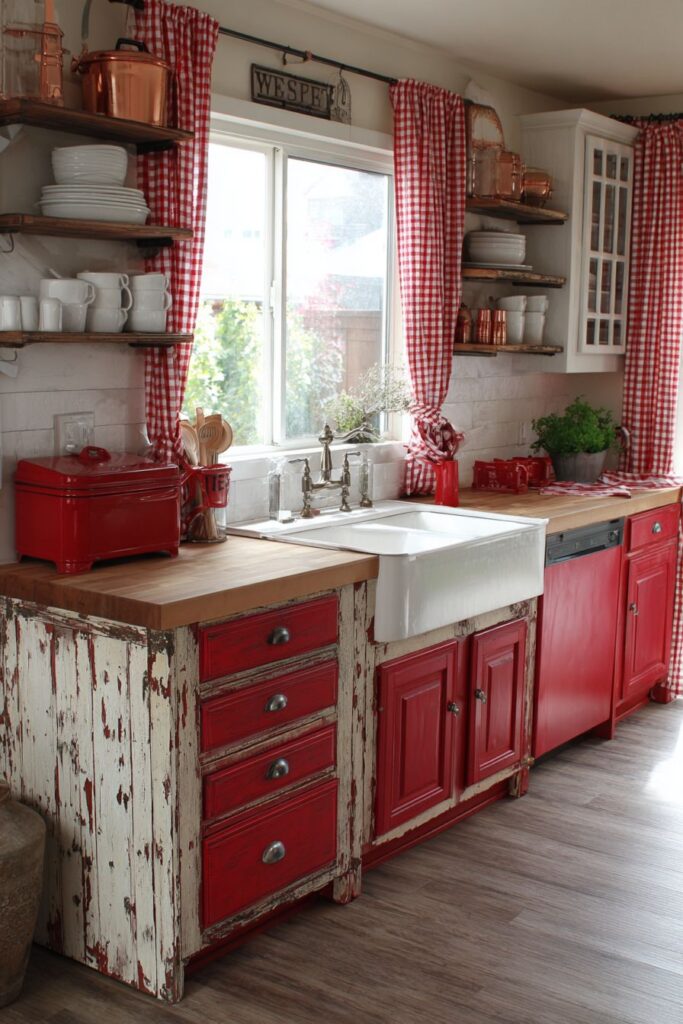
Key Design Tips:
- Use distressing techniques on painted surfaces to achieve authentic farmhouse character
- Display everyday dishes and cookware on open shelving for both function and visual interest
- Incorporate natural materials like butcher block and copper for warmth and authenticity
- Choose textiles like gingham that reinforce the farmhouse theme while adding color
- Layer vintage accessories throughout the space to build authentic period character
3. Contemporary Red Accent Drama
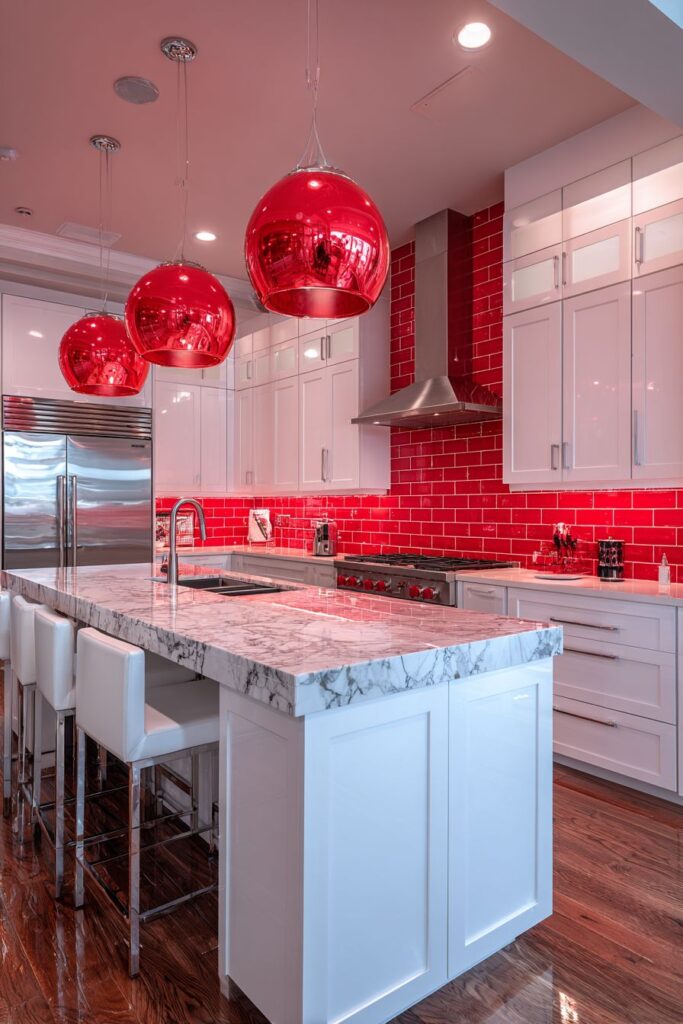
Transform your kitchen into a contemporary masterpiece with the strategic use of a dramatic red accent wall that serves as both backdrop and statement piece. This design demonstrates how a single bold color decision can completely transform a space without requiring a complete overhaul of existing elements. The textured red brick veneer behind the cooking area creates immediate visual impact while adding dimensional interest that flat paint simply cannot achieve. This approach allows homeowners to embrace the drama of red without committing to the color throughout the entire space.
The genius of this design lies in its restraint and balance. White shaker cabinets provide a clean, timeless foundation that allows the red wall to truly shine without competition. These classic cabinet doors offer the perfect neutral canvas, their simple lines and traditional proportions ensuring that they never go out of style. The marble countertops add a touch of luxury and sophistication, their natural veining providing organic movement that softens the geometric lines of the cabinetry and complements the textural interest of the brick wall.
The red pendant lights over the kitchen island create a brilliant design connection, tying the accent wall to other areas of the kitchen through strategic color repetition. This thoughtful approach to color distribution prevents the red from feeling isolated or randomly placed, instead creating a cohesive design narrative that guides the eye throughout the space. The stainless steel appliances maintain the contemporary aesthetic while providing necessary neutral elements that keep the overall design from becoming too bold or overwhelming.
Professional lighting design plays a crucial role in showcasing the various textures and materials in this kitchen. The interplay between smooth marble, textured brick, painted wood, and reflective steel creates a rich tapestry of surfaces that change throughout the day as natural light shifts and moves. Carefully placed task and accent lighting ensures that each material can be appreciated for its unique qualities while contributing to the overall harmony of the design.
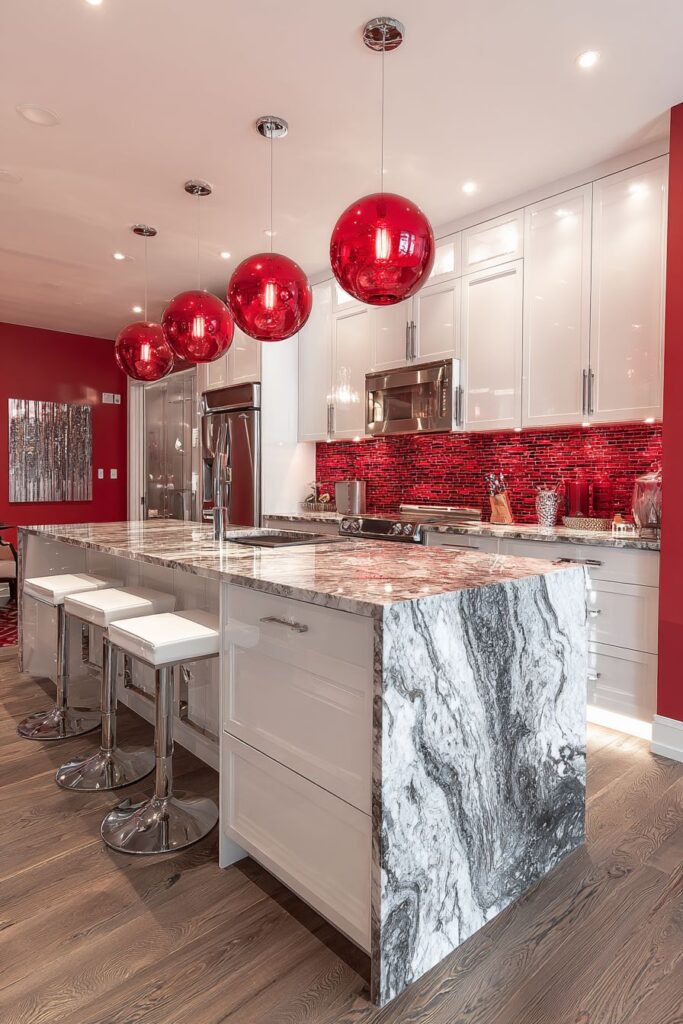
Key Design Tips:
- Use texture on accent walls to add dimensional interest beyond simple color application
- Balance bold accent colors with neutral cabinetry and countertops for visual harmony
- Repeat accent colors in smaller elements like lighting fixtures to create design cohesion
- Choose contemporary fixtures and appliances that complement rather than compete with bold color choices
- Layer different lighting types to highlight various textures and materials effectively
4. Small Space Red Energy
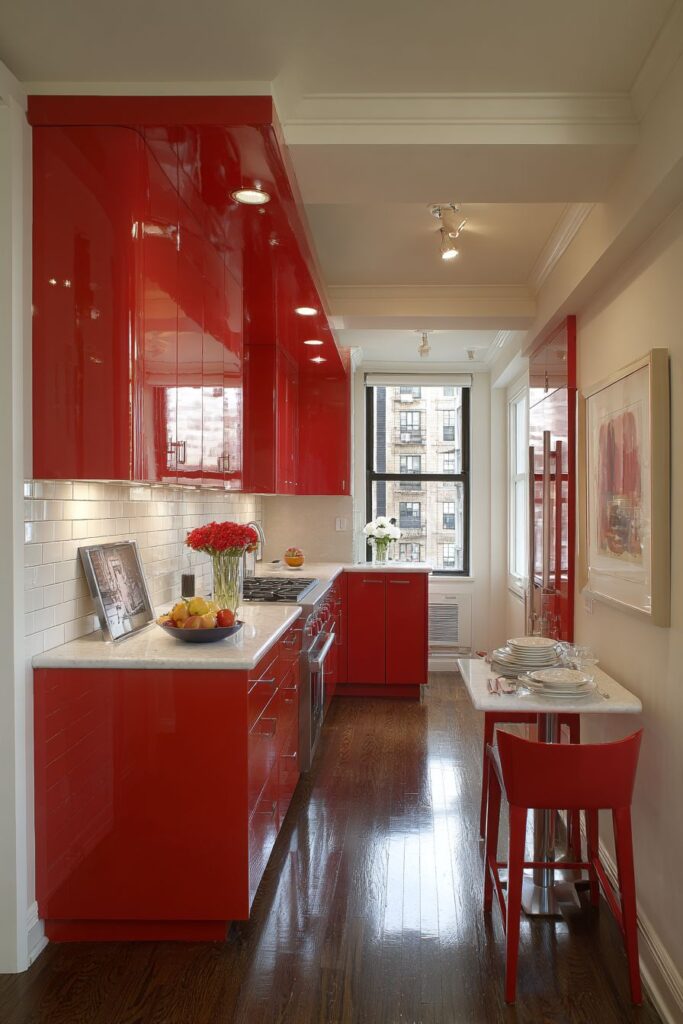
Maximize both style and function in compact living with this ingenious small apartment red kitchen that proves size limitations need never compromise design ambition. The red high-gloss cabinet doors serve a dual purpose in this clever design—their bold color energizes the space while their reflective surface creates the illusion of greater size and brightness. This strategic use of color psychology demonstrates how thoughtful material selection can overcome the challenges of limited square footage while creating a kitchen that feels both spacious and sophisticated.
The white subway tile backsplash that extends to the ceiling is a masterclass in visual manipulation, drawing the eye upward and creating the impression of greater height. This classic tile choice provides a timeless backdrop that allows the red cabinets to shine while contributing to the overall sense of cleanliness and brightness that’s essential in small spaces. The decision to carry the tile to the ceiling rather than stopping at a traditional height shows how breaking conventional rules can yield dramatic improvements in spatial perception.
The narrow breakfast bar with red bar stools transforms what could be dead space into valuable functional area while maintaining the color story throughout the kitchen. This multi-functional element serves as additional prep space, casual dining area, and social hub—proving that every square inch in a small kitchen must work overtime. The integrated LED under-cabinet lighting creates a warm, welcoming glow that makes the red surfaces appear to float above the countertop, adding visual lightness to what could otherwise feel like overwhelming color in a confined space.
Wide-angle interior photography reveals how thoughtful design can make even the smallest kitchens feel open and inviting. The key lies in understanding how different materials and finishes interact with light and space. The glossy red cabinets reflect light around the room, the white tiles amplify brightness, and the strategic lighting prevents any dark corners where the space might feel cramped or claustrophobic. This design proves that bold color choices aren’t just possible in small spaces—they’re often exactly what’s needed to create character and personality.
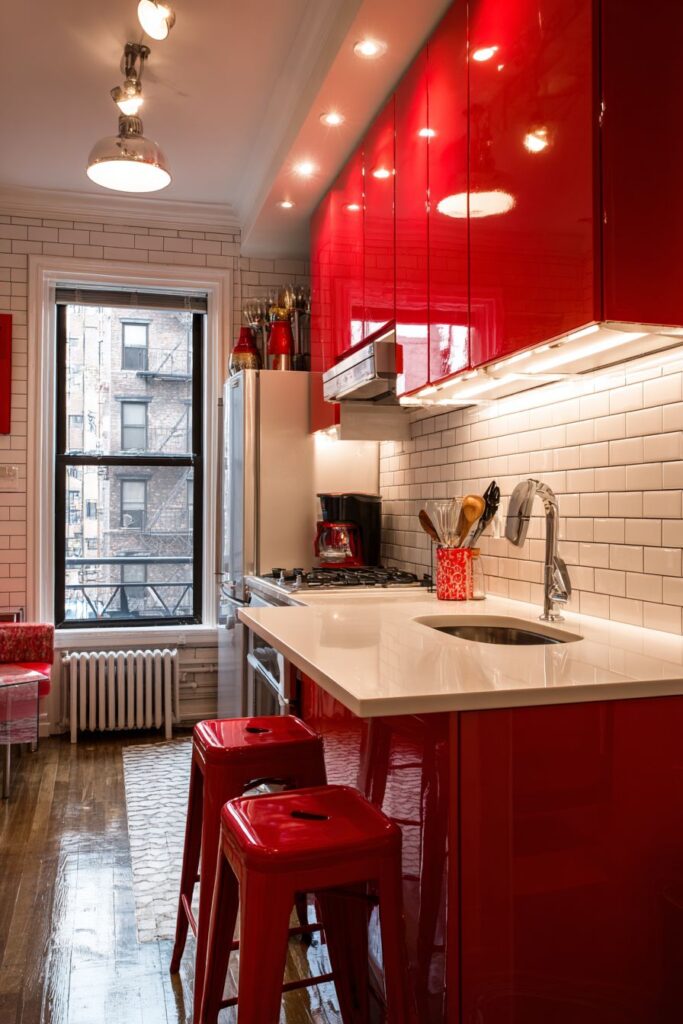
Key Design Tips:
- Choose high-gloss finishes in small spaces to reflect light and create illusions of greater size
- Extend backsplash tiles to the ceiling to maximize vertical visual space
- Incorporate multi-functional elements like breakfast bars to maximize utility in limited square footage
- Use under-cabinet lighting to create visual lightness and prevent color from feeling heavy
- Embrace bold colors in small spaces rather than defaulting to safe, neutral choices
5. Traditional Red Mahogany Sophistication
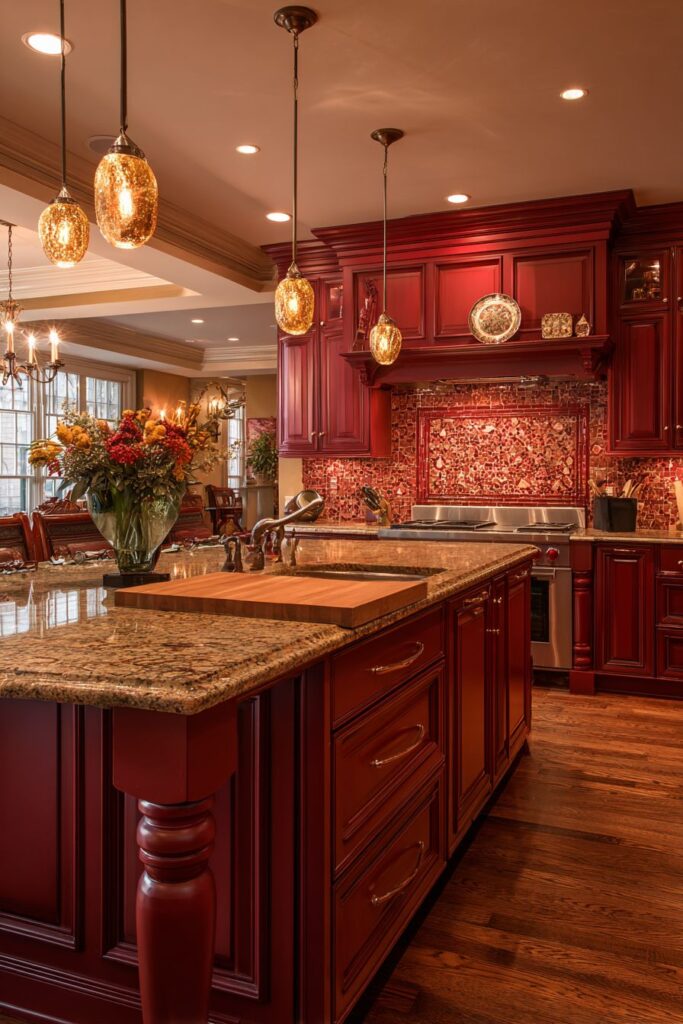
Enter a world of timeless elegance with this traditional red kitchen that celebrates the rich heritage of classic American design. The rich mahogany red raised-panel cabinets serve as the foundation of this sophisticated space, their deep color and traditional construction methods speaking to centuries of fine cabinetry craftsmanship. These cabinets represent more than mere storage—they’re furniture pieces that bring warmth, character, and undeniable presence to the kitchen. The brass hardware adds authentic period detail while complementing the warm undertones in the mahogany red finish.
The large red kitchen island with turned legs serves as the room’s centerpiece, its furniture-like appearance reinforcing the traditional aesthetic while providing essential functionality. The butcher block top offers an ideal surface for food preparation while adding natural warmth that complements the painted base. This combination of painted wood and natural timber creates visual interest and textural contrast that prevents the design from feeling flat or monochromatic. The island’s substantial size and traditional proportions make it both a practical workspace and an impressive architectural feature.
Cream-colored granite countertops provide elegant contrast to the rich red cabinetry while offering the durability and functionality that modern kitchens demand. The subtle variations in the natural stone add organic interest that complements the traditional aesthetic while providing a neutral foundation that allows the red elements to truly shine. The decorative red tile backsplash reinforces the color story while adding pattern and visual interest to the wall surfaces.
The lighting design in this traditional kitchen relies on warm pendant lights that create an inviting atmosphere reminiscent of historic homes where cooking and gathering were central to family life. Professional photography captures not just the visual elements but the emotional warmth that makes traditional kitchens so enduringly popular. This design proves that traditional doesn’t mean outdated—when executed with quality materials and thoughtful proportions, classic design principles create spaces that feel both timeless and thoroughly contemporary.
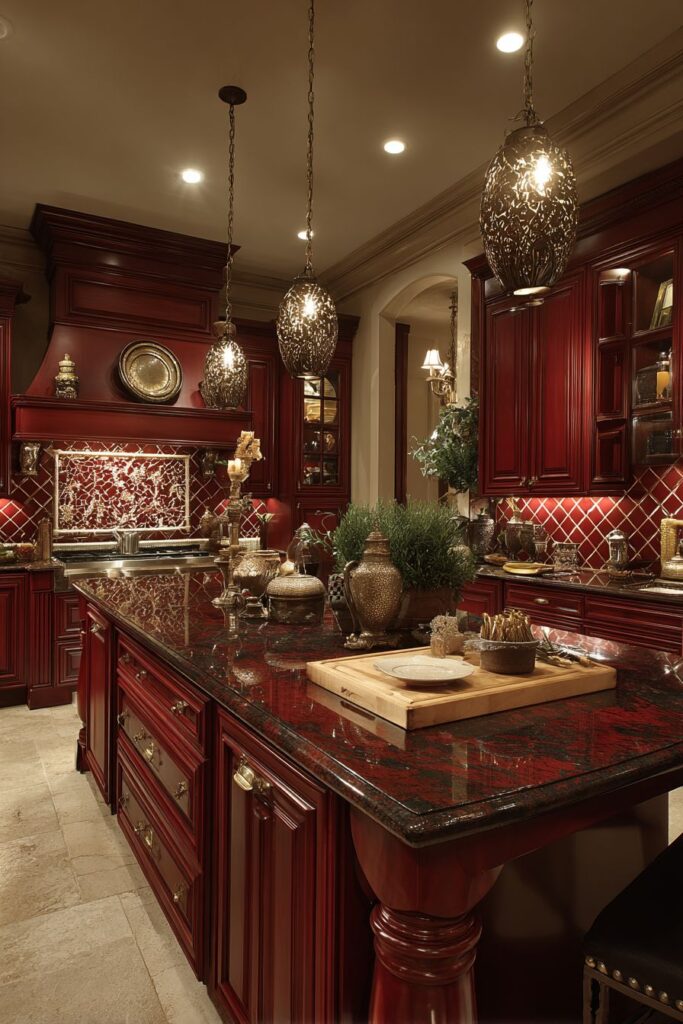
Key Design Tips:
- Invest in quality raised-panel cabinetry with authentic construction details for lasting traditional appeal
- Use furniture-style islands with turned legs and mixed materials to create focal points
- Choose natural materials like granite and butcher block that age beautifully over time
- Select brass or bronze hardware that complements warm red tones in traditional finishes
- Layer warm lighting throughout the space to enhance the cozy, traditional atmosphere
6. Red Accessory Accent Mastery

Discover the art of subtle sophistication with this masterful approach to red kitchen decor that proves dramatic color doesn’t always require dramatic commitment. This design demonstrates how carefully curated red accessories can transform a neutral kitchen into a space with personality and warmth without overwhelming the existing architecture or requiring major renovation. The neutral white cabinets provide a clean, timeless foundation that allows the red elements to shine while maintaining maximum flexibility for future design changes.
The strategic placement of red ceramic canisters, a red stand mixer, and vibrant red dish towels creates visual interest and functional beauty throughout the space. These elements work together to establish a cohesive color story while serving essential daily functions—proving that beautiful design need never sacrifice practicality. The brushed gold hooks add a touch of warmth and sophistication while providing practical storage for the colorful textiles that bring life to the space.
The red runner rug serves as an anchor for the color scheme while defining the primary workspace and adding comfort underfoot during long cooking sessions. This practical element demonstrates how textiles can be used to introduce color in ways that are easily changeable as tastes evolve or seasons change. The red potted herbs on the windowsill add living color while serving the dual purpose of providing fresh ingredients for cooking—a perfect example of how functional elements can also serve decorative purposes.
Natural daylight streaming through sheer curtains provides the perfect illumination for this carefully curated collection of red accessories. This soft, diffused lighting allows each element to contribute to the overall design without any single piece overwhelming the composition. The beauty of this approach lies in its accessibility—homeowners can achieve dramatic transformation through thoughtful accessory selection rather than major renovation, making great design available to any budget.

Key Design Tips:
- Curate accessories in consistent color tones for cohesive impact without overwhelming the space
- Choose functional accessories that serve daily needs while contributing to the design aesthetic
- Use textiles like rugs and towels to introduce color in easily changeable ways
- Incorporate living elements like herbs that provide color while serving practical purposes
- Layer accessories at different heights and locations to create visual flow throughout the space
7. Industrial Red Edge Appeal
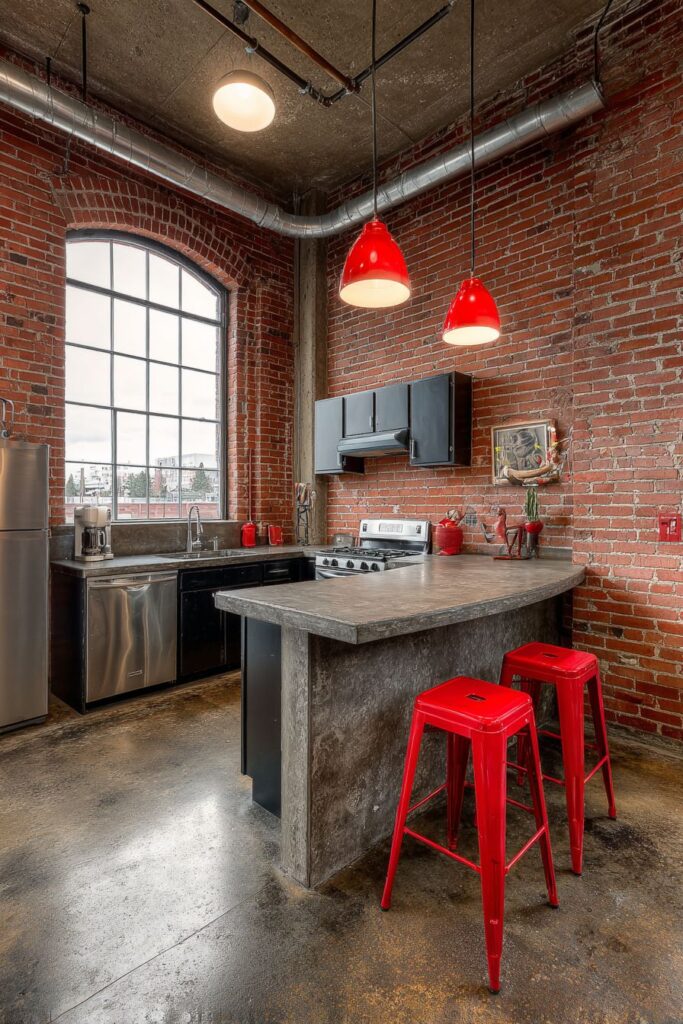
Embrace the raw beauty of urban design with this industrial red kitchen that celebrates the aesthetic of exposed materials and honest construction. The exposed red brick walls serve as both structural element and decorative feature, their weathered surface and rich color creating immediate character and warmth in what could otherwise be a cold, utilitarian space. This approach to wall treatment demonstrates how architectural features can serve multiple purposes while adding authenticity that cannot be manufactured or faked.
The black metal cabinets provide a perfect foil to the warm red brick, their sleek lines and matte finish creating striking contrast while maintaining the industrial aesthetic. These cabinets prove that storage solutions can be both highly functional and visually dramatic, their powder-coated finish offering durability while their simple forms celebrate the beauty of purposeful design. The red bar-height stools with metal frames continue the material story while providing comfortable seating that doesn’t compromise the space’s edgy aesthetic.
Concrete countertops add to the urban edge while providing an incredibly durable and unique surface for food preparation. These custom surfaces can be tinted and finished to complement the red brick while offering the industrial authenticity that makes this design so compelling. The concrete’s neutral gray tone provides visual rest between the dramatic red and black elements while contributing to the overall sense of honest, unadorned materials.
The red industrial pendant lights hanging over the workspace serve as both functional task lighting and decorative elements that reinforce the color scheme. These fixtures demonstrate how utilitarian lighting can be transformed into design statements through thoughtful selection and placement. Professional interior photography with dramatic lighting emphasizes the interplay between rough and smooth textures, warm and cool tones, creating a space that feels both edgy and inviting.
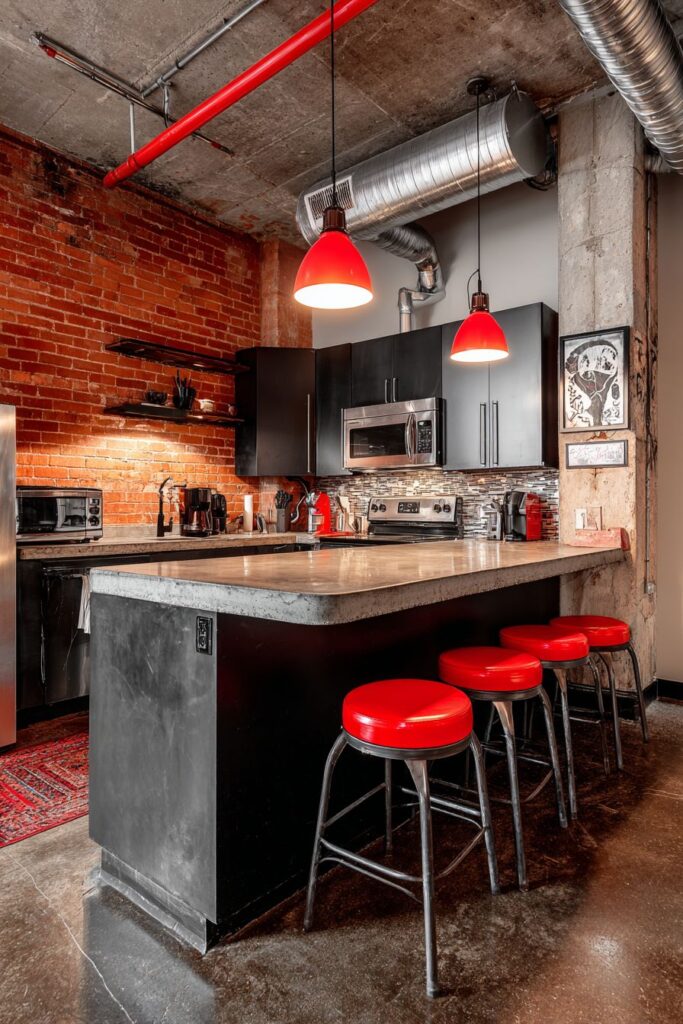
Key Design Tips:
- Embrace exposed architectural elements like brick walls for authentic industrial character
- Mix warm and cool tones to create visual interest while maintaining the industrial aesthetic
- Choose fixtures and furniture with metal frames that complement the industrial theme
- Use concrete surfaces for unique, durable countertops that improve with age
- Incorporate dramatic lighting that highlights the contrast between different materials and textures
8. Red Marble Statement Luxury
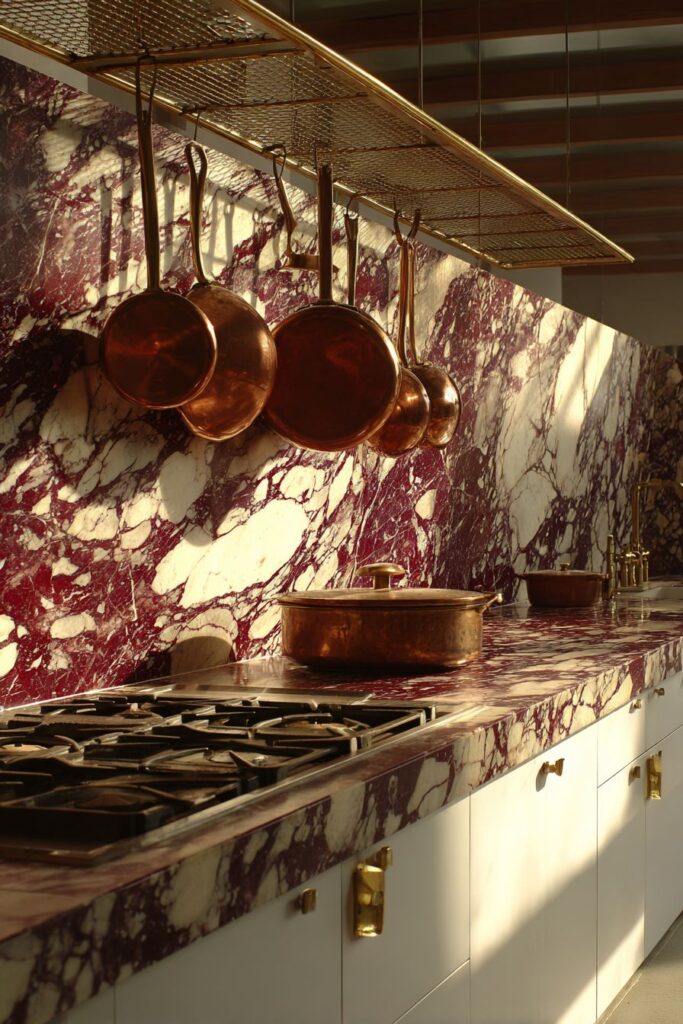
Experience the ultimate in kitchen luxury with this stunning design that showcases a dramatic red marble backsplash as its centerpiece. The natural stone extends from counter to ceiling behind the range, creating a breathtaking focal point that demonstrates the incredible beauty possible when natural materials take center stage. The white veining throughout the marble adds movement and visual interest while lightening the overall effect and preventing the red from feeling too heavy or overwhelming in the space.
The decision to use white cabinetry throughout the rest of the kitchen demonstrates sophisticated restraint, allowing the magnificent marble to command attention without competition. These clean, simple cabinet doors provide a neutral foundation that showcases the natural stone’s inherent beauty while maintaining a sense of elegance and refinement. The brass fixtures add warmth and sophistication, their golden tones complementing the red marble while adding a touch of traditional luxury that elevates the entire design.
The red copper pots hanging from a ceiling rack create a brilliant design connection, echoing the marble’s color while serving essential functional purposes. This practical storage solution demonstrates how everyday cooking tools can become decorative elements when chosen thoughtfully and displayed with care. The copper’s warm tones bridge the gap between the cool white cabinetry and the warm red marble, creating a harmonious color palette that feels both sophisticated and inviting.
Balanced natural lighting is crucial to showcasing the unique characteristics of natural stone. The intricate veining patterns and subtle color variations in the marble change throughout the day as light shifts and moves, creating an ever-evolving backdrop for culinary activities. Professional lighting design ensures that both natural and artificial illumination work together to highlight the stone’s beauty while providing adequate task lighting for cooking and food preparation.

Key Design Tips:
- Invest in book-matched marble slabs for dramatic veining patterns and visual continuity
- Use natural stone as a statement element against neutral backgrounds for maximum impact
- Choose hardware and fixtures in warm metals that complement red tones in natural stone
- Display cookware that echoes the stone’s color for cohesive design storytelling
- Plan lighting carefully to showcase natural stone’s beauty throughout the day
9. Scandinavian Red Warmth
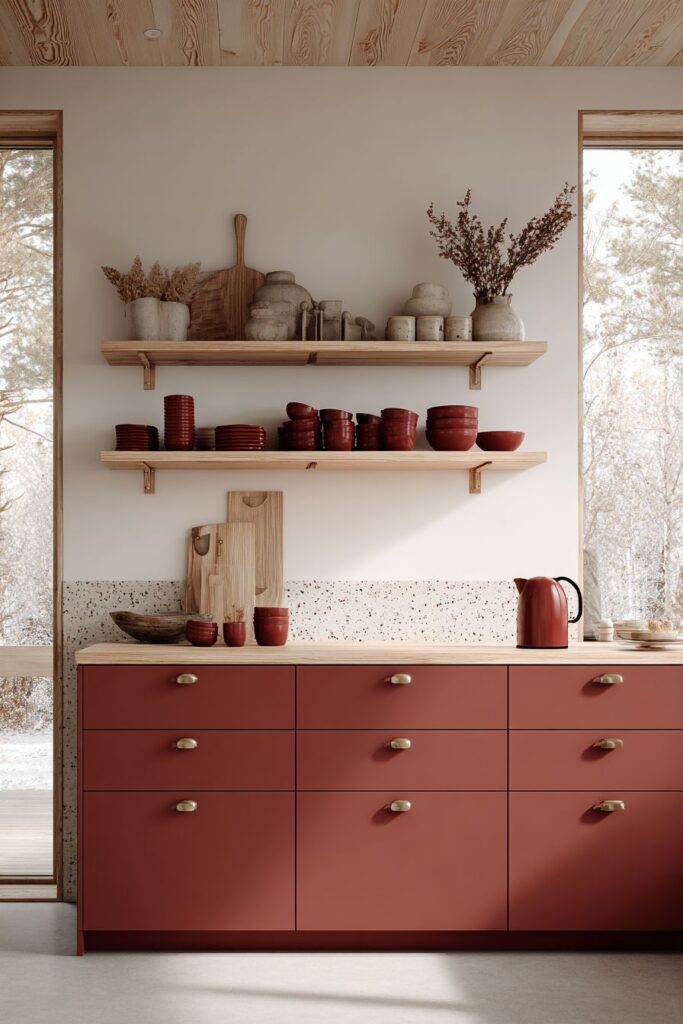
Discover the perfect marriage of Nordic minimalism and warm color in this Scandinavian-inspired red kitchen that redefines our understanding of cold-climate design. The matte red cabinet doors in a warm terracotta shade demonstrate how Scandinavian design principles can embrace bold color while maintaining the clean lines and functional beauty that define this beloved aesthetic. This particular shade of red evokes the warmth of autumn leaves and clay pottery, bringing natural warmth to the characteristically cool Nordic palette.
The light oak open shelving and countertops provide the natural wood elements that are essential to authentic Scandinavian design while offering beautiful contrast to the painted cabinets. The wood’s light tone and visible grain patterns add organic texture and warmth that prevents the minimalist aesthetic from feeling cold or sterile. This combination of painted and natural wood finishes creates visual interest while maintaining the harmony and balance that Scandinavian design demands.
White walls and simple brass hardware maintain the minimalist aesthetic that defines Scandinavian style while allowing the red cabinets to serve as the room’s primary color statement. The brass hardware adds just enough warmth to complement the red tones without overwhelming the clean lines and simple forms that make this design so appealing. The red ceramic dishes and vintage red coffee pot displayed on the open shelving add authentic Nordic charm while demonstrating how functional items can serve as decorative elements.
The lighting strategy relies heavily on soft diffused natural light through large windows, creating the characteristic Nordic ambiance that makes these spaces feel so calm and welcoming. This approach to illumination emphasizes the natural materials and celebrates the subtle imperfections that make handcrafted elements so appealing. The overall effect is a kitchen that feels both thoroughly modern and deeply rooted in Scandinavian design traditions.
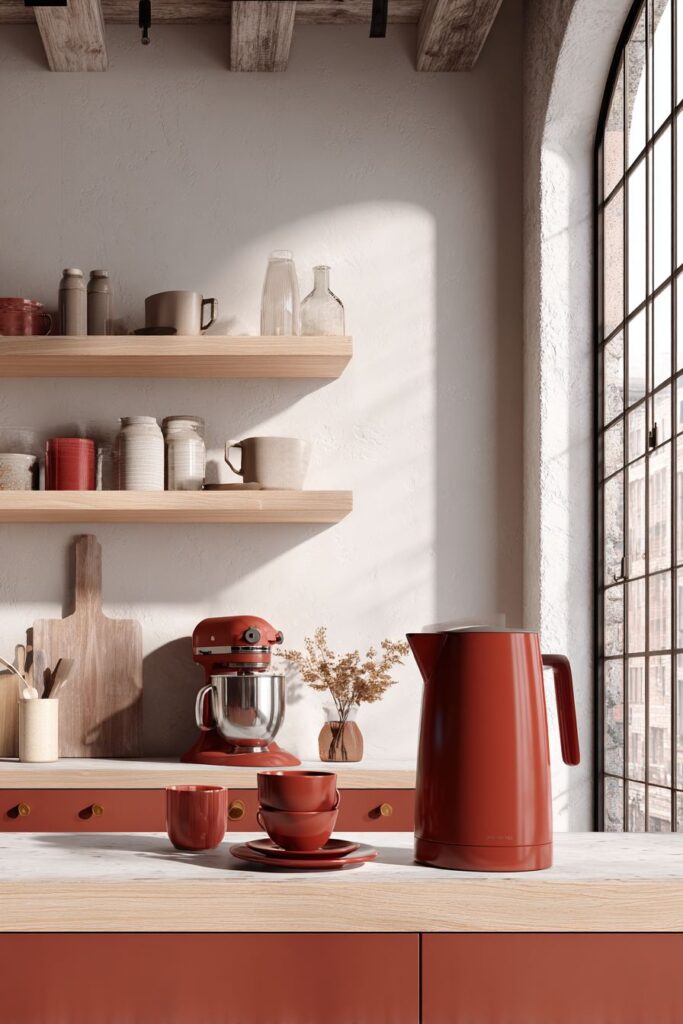
Key Design Tips:
- Choose matte finishes in earthy red tones that complement natural wood elements
- Incorporate light-colored woods like oak or birch for authentic Scandinavian character
- Maintain clean lines and simple forms while allowing natural materials to add warmth
- Display functional ceramics and cookware as decorative elements on open shelving
- Maximize natural light to create the bright, airy feeling essential to Nordic design
10. Red Island Focal Point
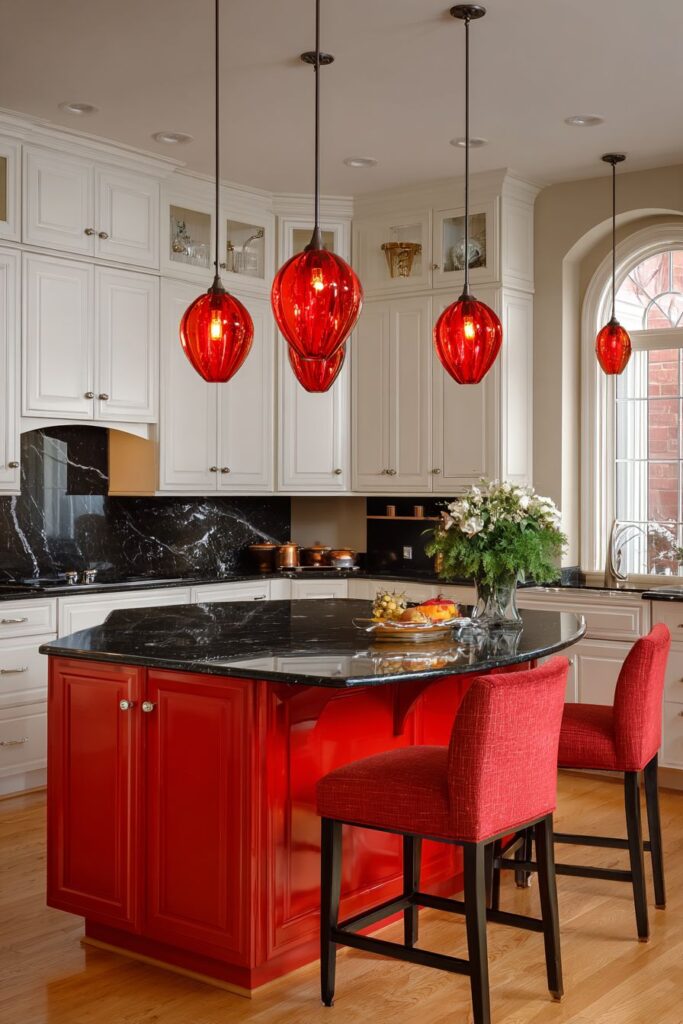
Create a stunning centerpiece with this design that showcases a bold red kitchen island as the undisputed star of the space. The waterfall edges on this magnificent island demonstrate how contemporary design can be both dramatic and sophisticated, the continuous surface flowing seamlessly from horizontal to vertical planes creating clean lines that epitomize modern aesthetics. This approach to countertop design transforms a functional workspace into a sculptural element that anchors the entire kitchen design.
The contrast between the red island and white perimeter cabinets creates visual drama while maintaining perfect balance in the overall composition. This two-tone approach allows homeowners to embrace bold color without overwhelming the space, creating a design that feels both dramatic and livable. The black granite countertops on the perimeter provide sophisticated contrast while offering durability and functionality for daily food preparation tasks.
The island’s built-in seating with red upholstered bar stools transforms this workspace into a social hub where family and friends can gather while meals are being prepared. The integrated storage within the island maximizes functionality while maintaining clean lines, proving that practical considerations need never compromise design beauty. The pendant lights with red glass shades illuminate the workspace while reinforcing the color story and adding another layer of sophisticated detail.
Wide-angle interior design photography captures the island as the focal point while maintaining proper proportions throughout the space. The careful balance of colors, materials, and lighting creates a kitchen that feels both grand and intimate, suitable for both everyday family meals and elegant entertaining. This design demonstrates how a single bold element can transform an entire space while maintaining functionality and livability.
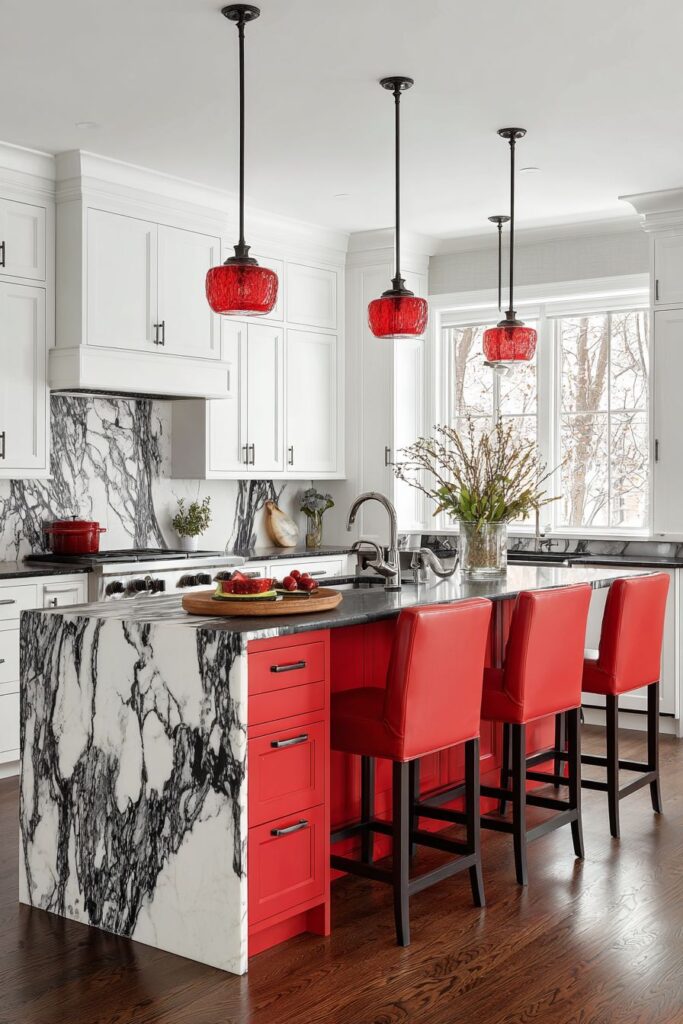
Key Design Tips:
- Use waterfall countertops to create dramatic focal points that serve as sculptural elements
- Balance bold island colors with neutral perimeter cabinetry for visual harmony
- Incorporate seating and storage into islands to maximize functionality in a single element
- Choose lighting fixtures that complement and reinforce the island’s color story
- Plan sight lines carefully to ensure the island enhances rather than overwhelms the space
11. Vintage Red Retro Revival
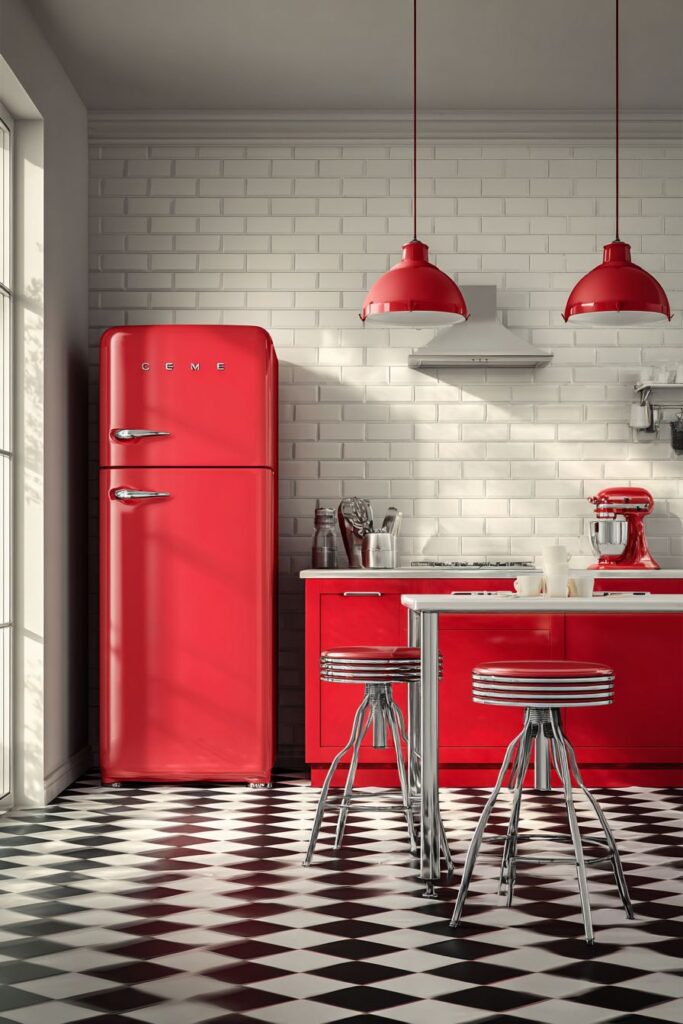
Step back in time with this authentic vintage red kitchen that captures the optimism and style of 1950s American design. The retro red appliances, including a classic red refrigerator and matching range, serve as the stars of this nostalgic design, their authentic styling and bold color creating immediate visual impact while providing modern functionality. These statement appliances demonstrate how contemporary technology can be housed in vintage-inspired designs that honor the past while serving present-day needs.
The white subway tile provides a classic backdrop that was as popular in the 1950s as it is today, proving that some design elements truly are timeless. The checkered black and white floor tiles add authentic period detail while creating visual interest and movement throughout the space. This classic pattern choice reinforces the retro theme while providing a durable, easy-to-clean surface that meets the demands of contemporary kitchen use.
The red vinyl bar stools at a chrome-legged table complete the authentic 1950s aesthetic while providing comfortable seating for casual dining and social gathering. Chrome fixtures and accessories throughout the space maintain period authenticity while adding reflective surfaces that bounce light around the room and prevent the bold colors from feeling heavy or overwhelming. These carefully chosen details demonstrate how authentic vintage design requires attention to every element, from major appliances to the smallest accessories.
The lighting strategy combines natural illumination with vintage-style pendant lights that create the perfect ambiance to showcase this authentic retro design. The warm glow of period-appropriate fixtures enhances the nostalgic atmosphere while providing adequate task lighting for cooking and food preparation. This careful attention to lighting details helps create a space that feels genuinely vintage rather than merely vintage-inspired.
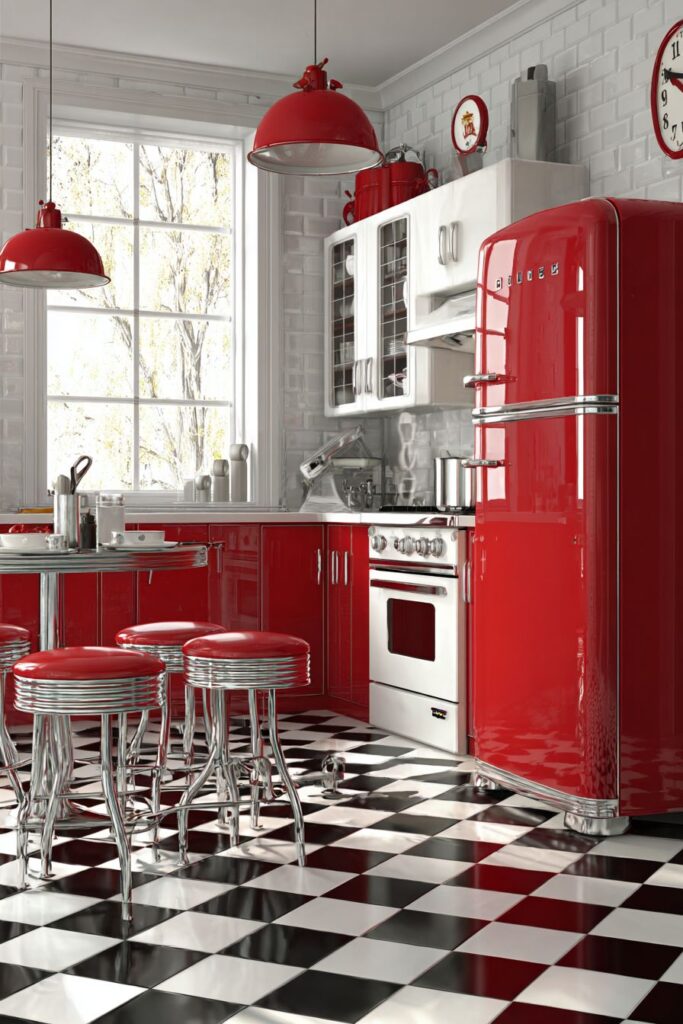
Key Design Tips:
- Invest in authentic vintage-style appliances that combine retro aesthetics with modern functionality
- Use classic patterns like checkered floors and subway tiles for genuine period authenticity
- Choose chrome and vinyl materials that were popular during the target era
- Layer period-appropriate lighting fixtures to enhance the nostalgic atmosphere
- Pay attention to small details like hardware and accessories to maintain authentic vintage character
12. Red Open Shelving Display
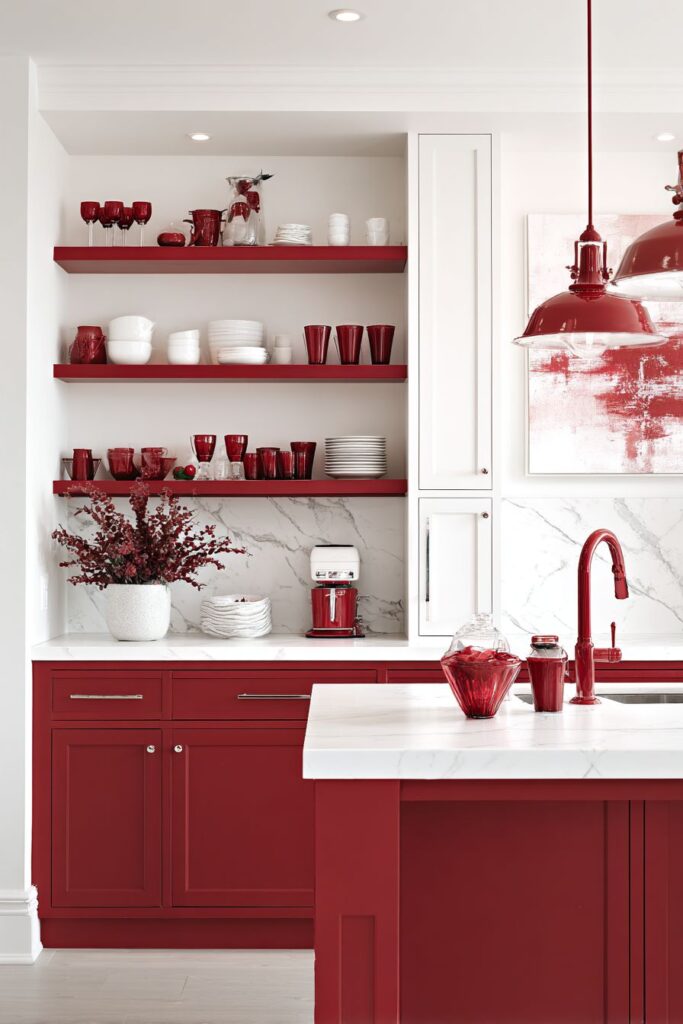
Master the art of functional display with this sophisticated approach to red open shelving that transforms storage into decorative art. The deep crimson red shelving serves as both practical storage and striking visual element, its bold color creating immediate impact while providing the perfect backdrop for displaying beautiful dishware and glassware. This approach to kitchen storage demonstrates how utilitarian elements can become the stars of the design when planned and executed thoughtfully.
The strategic display of white dinnerware and red glassware creates a cohesive color story that feels both intentional and effortless. This careful curation demonstrates how everyday items can become decorative elements when chosen and arranged with an eye for color, proportion, and visual balance. The contrast between the white dishes and red shelving creates visual interest while maintaining the organized, uncluttered appearance that makes open shelving successful.
The rest of the kitchen features white shaker cabinets and marble countertops, providing a neutral foundation that allows the red shelving to be the statement element without overwhelming the space. This restrained approach to color placement demonstrates sophisticated design thinking—using bold color strategically rather than throughout the entire space. The red pendant lights over the sink area tie the design together while providing necessary task lighting for daily activities.
Professional photography with balanced exposure highlights how organized display and strategic color placement can transform a kitchen’s entire character. The beauty of this approach lies in its flexibility—homeowners can easily change the display items seasonally or as tastes evolve, making this a dynamic design that can grow and change over time while maintaining its fundamental appeal.
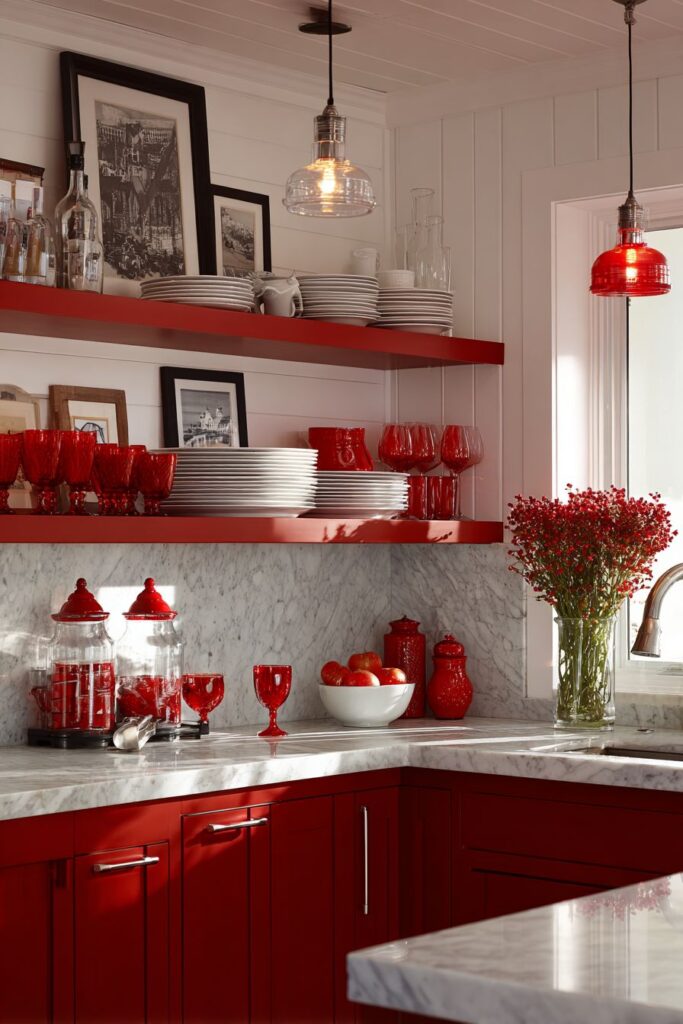
Key Design Tips:
- Paint open shelving in bold colors to create impact while maintaining functionality
- Curate displays with consistent color stories for cohesive visual impact
- Use neutral backgrounds to allow colorful shelving to serve as the primary design element
- Repeat accent colors in other elements like lighting to create design unity
- Organize displays thoughtfully to maintain the clean, uncluttered look essential to open shelving success
13. Mediterranean Red Warmth
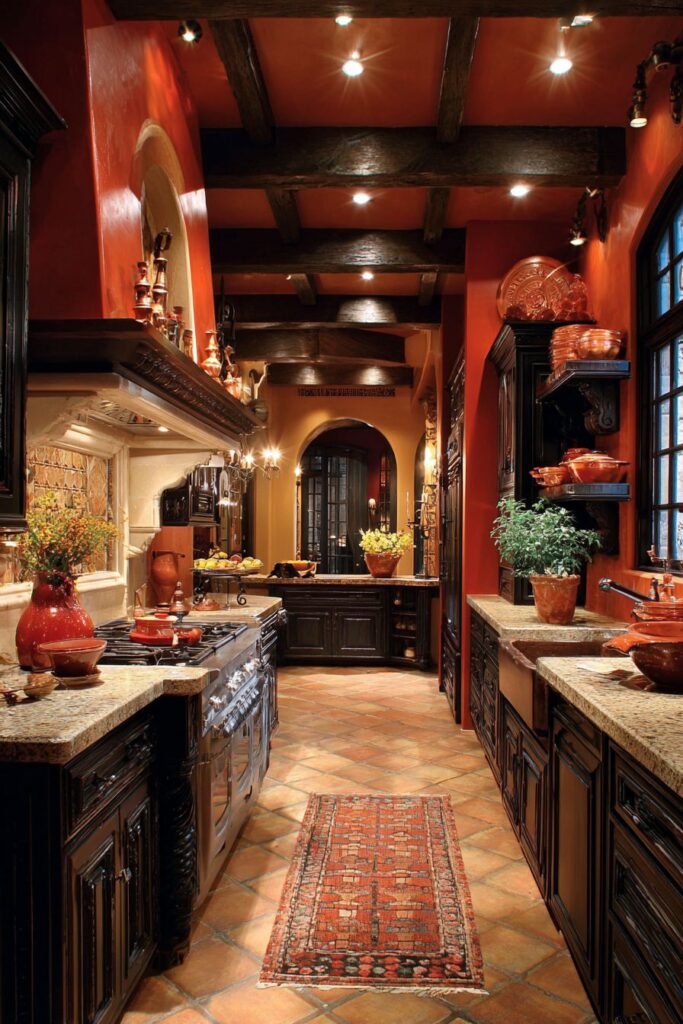
Transport yourself to the sun-soaked landscapes of the Mediterranean with this warm and inviting red kitchen that celebrates the rich traditions of southern European design. The terra cotta red clay tile backsplash immediately establishes the regional character while adding natural texture and authentic color that speaks to centuries of traditional Mediterranean craftsmanship. The warm red painted walls complement the natural clay tones while creating an enveloping sense of warmth that makes this kitchen feel like a true gathering place.
The dark wood cabinets with wrought iron hardware add authenticity and visual weight that grounds the warm color palette while providing essential storage. These traditional cabinet styles, with their substantial construction and decorative details, reflect the furniture-making traditions of Mediterranean regions where craftsmanship and durability are equally valued. The wrought iron hardware adds another layer of authentic detail while complementing the rustic aesthetic that defines this style.
Natural stone countertops and a large wood beam across the ceiling add rustic charm while introducing natural materials that age beautifully over time. These elements demonstrate how Mediterranean design celebrates the beauty of natural materials in their honest, unrefined state. The red ceramic bowls and copper cookware displayed on open shelves enhance the regional aesthetic while serving practical functions, proving that beautiful design can be completely functional.
Warm ambient lighting creates a cozy atmosphere while highlighting the rich textures and earthy red tones throughout the space. The lighting strategy emphasizes the handcrafted quality of the materials while creating the golden, welcoming glow that makes Mediterranean kitchens so appealing. This careful attention to illumination helps create a space that feels both elegant and comfortable, suitable for both daily family meals and festive gatherings.
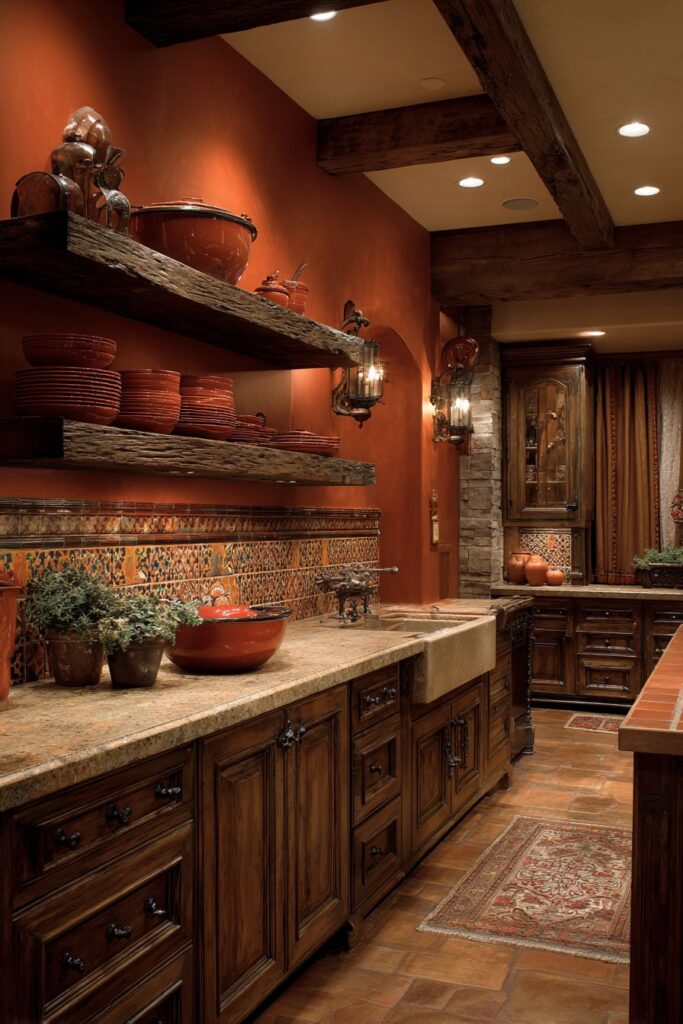
Key Design Tips:
- Use natural clay tiles and terra cotta colors for authentic Mediterranean character
- Choose dark wood cabinetry with substantial construction and traditional proportions
- Incorporate wrought iron details and natural stone for rustic authenticity
- Display functional ceramics and cookware as decorative elements
- Plan warm, ambient lighting to enhance the cozy, gathering-place atmosphere
14. Red Herringbone Floor Foundation
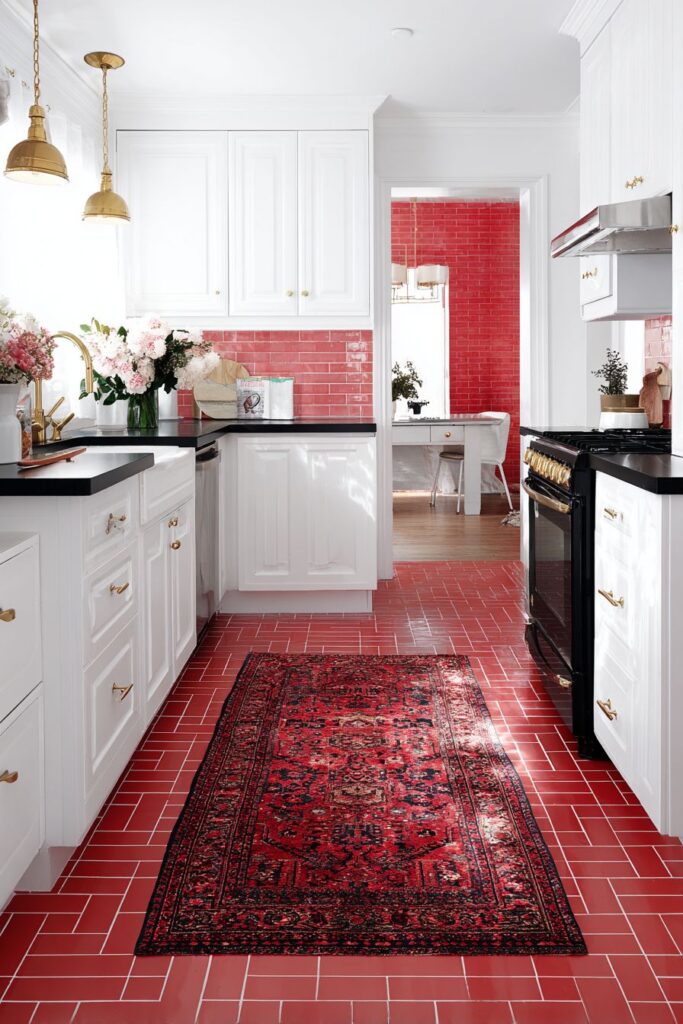
Ground your kitchen design with the sophisticated pattern and rich color of a red ceramic tile floor arranged in a classic herringbone pattern. This flooring choice serves as both foundation and focal point, its intricate geometric arrangement adding visual interest and movement throughout the space while providing a durable, easy-to-maintain surface that stands up to the demands of daily kitchen use. The herringbone pattern demonstrates how traditional laying techniques can create contemporary visual impact when executed with bold color choices.
The pairing of this dramatic floor with white cabinets and black countertops creates a timeless color combination that feels both classic and thoroughly modern. This tricolor scheme provides perfect balance—the white cabinets keep the space feeling bright and clean, the black countertops add sophisticated contrast, and the red floor injects personality and warmth. The red ceramic subway tiles creating an accent wall behind the range reinforce the color story while adding another layer of visual interest.
Brass fixtures throughout the space add warmth and sophistication, their golden tones complementing the red flooring while providing necessary contrast to the black and white elements. These fixtures demonstrate how hardware selection can tie together different design elements while adding a touch of luxury that elevates the entire space. The red vintage rug defining the cooking area adds comfort underfoot while creating a visual boundary that helps organize the space.
Interior design photography captures the intricate floor pattern detail while showing how red flooring can ground the entire kitchen design. The photographer’s attention to the interplay between pattern, color, and light demonstrates how flooring choices can dramatically impact a space’s overall character. This design proves that floors can be much more than merely functional surfaces—when chosen thoughtfully, they become integral design elements that influence every other decision in the space.
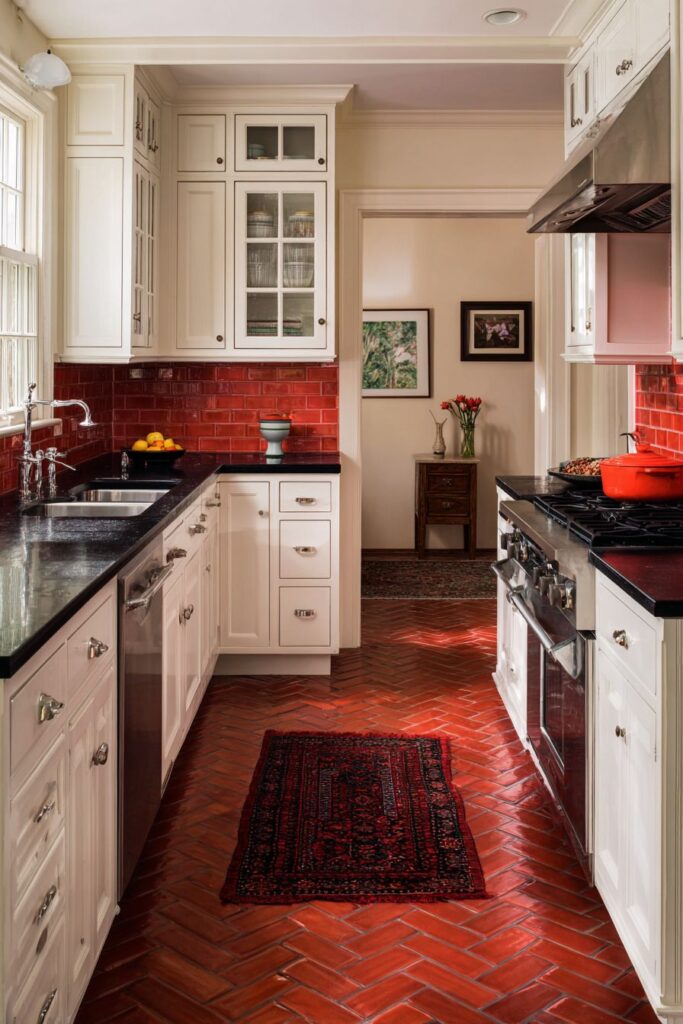
Key Design Tips:
- Use classic patterns like herringbone to add visual interest while maintaining timeless appeal
- Balance bold floor colors with neutral cabinetry and contrasting countertops
- Repeat floor colors in accent elements like backsplash tiles for design cohesion
- Choose warm metal fixtures that complement red tones while adding sophistication
- Add area rugs to define specific zones while providing comfort in work areas
15. Red Quartz Luxury Surfaces
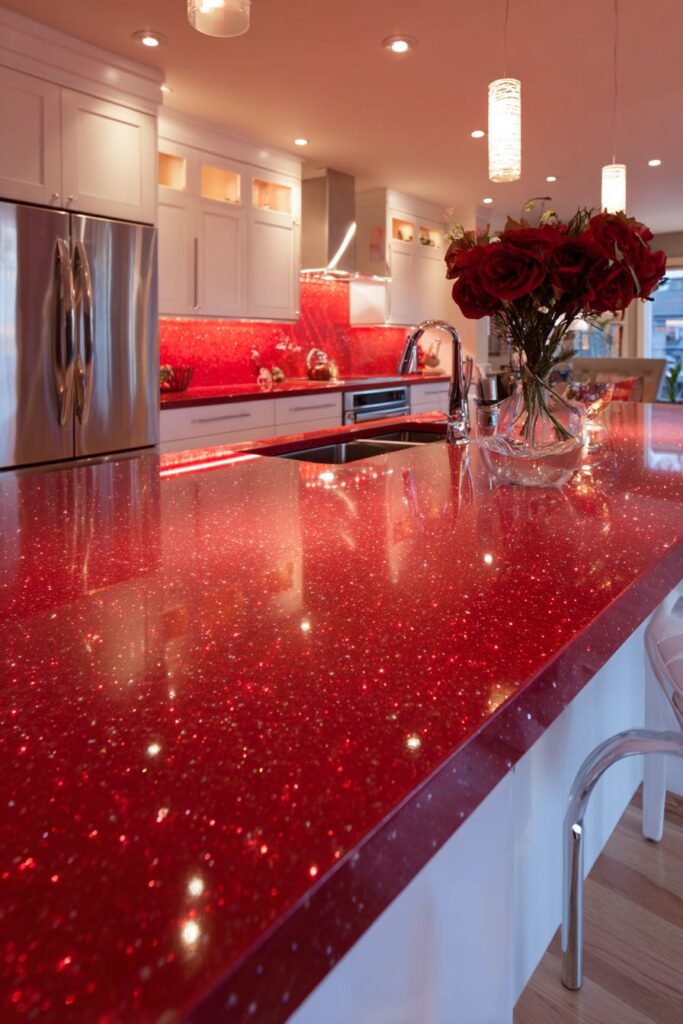
Experience the ultimate in modern luxury with this sophisticated kitchen featuring sleek red quartz countertops that showcase the beauty possible when cutting-edge materials meet bold design vision. The subtle sparkle within the quartz surfaces adds depth and visual interest while maintaining the clean lines and sophisticated appearance that define contemporary design. These engineered surfaces offer the perfect combination of beauty and practicality, providing stunning visual impact while delivering the durability and low maintenance that modern homeowners demand.
The pairing of red quartz countertops with white flat-panel cabinets creates a striking contrast that feels both dramatic and sophisticated. The clean lines of the flat-panel doors complement the sleek quartz surfaces while providing a neutral foundation that allows the red to truly shine. The matching red quartz backsplash creates visual continuity while simplifying the overall design and allowing the natural beauty of the stone to take center stage.
The integrated red LED lighting under the cabinets creates a dramatic glow that transforms the kitchen’s appearance during evening hours. This innovative lighting solution demonstrates how technology can enhance natural materials while providing practical task illumination. The LEDs can be programmed to different intensities and even different colors, allowing homeowners to adjust the space’s mood and character for different occasions and times of day.
Stainless steel appliances maintain the contemporary feel while providing necessary neutral elements that prevent the design from becoming overwhelming. Professional lighting emphasizes the luxurious quality of the red quartz surfaces and their reflective properties while maintaining realistic color representation. This careful attention to lighting design ensures that the natural beauty of the quartz can be appreciated throughout the day while providing excellent functionality for cooking and food preparation.
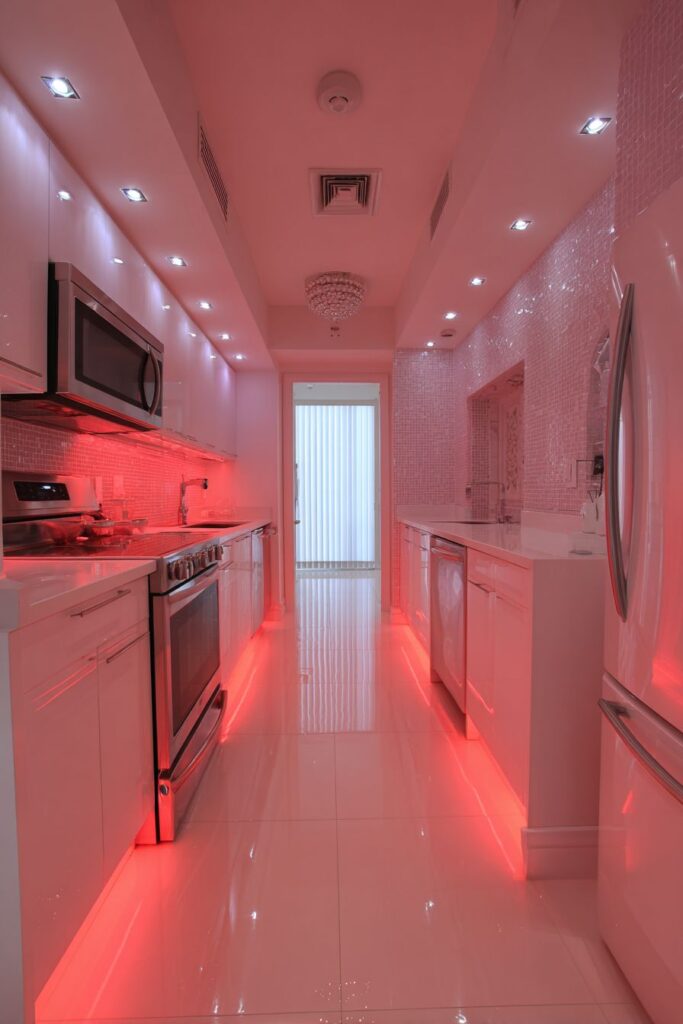
Key Design Tips:
- Choose engineered quartz for consistent color and pattern with superior durability
- Use integrated LED lighting to enhance surface sparkle and create dramatic evening ambiance
- Pair bold countertop colors with simple cabinet styles for balanced visual impact
- Maintain color continuity between countertops and backsplash for sophisticated unity
- Select neutral appliances that complement rather than compete with bold surface materials
16. Red Glass Cabinet Transparency
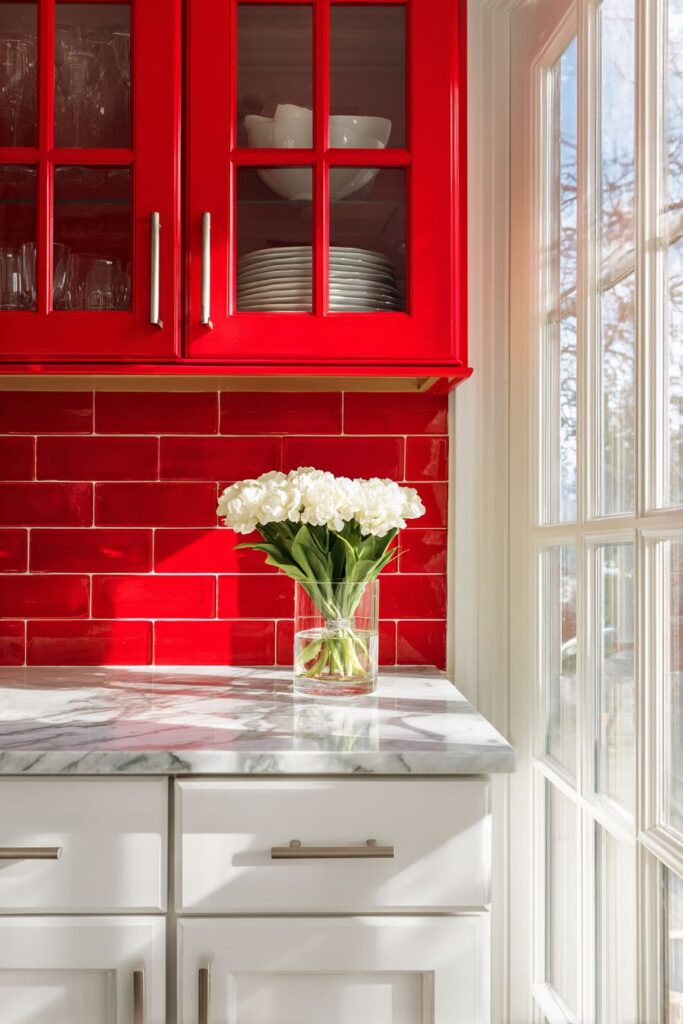
Achieve the perfect balance between concealment and display with this innovative approach featuring red painted glass cabinet doors on upper cabinets. This sophisticated solution allows dishes and glassware to show through while adding vibrant color to the kitchen design. The transparency of the glass prevents the red from overwhelming the space while creating visual interest and depth that solid doors simply cannot achieve. This approach demonstrates how traditional cabinetry concepts can be reimagined for contemporary living.
The white lower cabinets provide balance and visual weight while ensuring adequate concealed storage for less attractive kitchen necessities. The Carrara marble countertops add elegance and sophistication while providing beautiful contrast to both the red glass and white cabinetry. The natural veining in the marble adds organic movement that softens the geometric lines of the cabinetry while contributing to the overall sense of luxury and refinement.
The red tile backsplash in a subway pattern with dark grout adds texture and visual interest while reinforcing the color story established by the glass cabinet doors. The dark grout creates definition and prevents the design from feeling too flat or monochromatic while adding contemporary detail that updates the classic subway tile pattern. Brushed nickel hardware and fixtures maintain the transitional style while providing neutral metallic elements that complement both the red and white components.
Natural lighting filters through the glass cabinet doors throughout the day, creating constantly changing visual interest and depth as the light moves and shifts. This dynamic quality adds life to the kitchen while showcasing the beautiful dishes and glassware within. The interplay between transparency and opacity, color and neutrality, creates a sophisticated design that feels both contemporary and timeless.
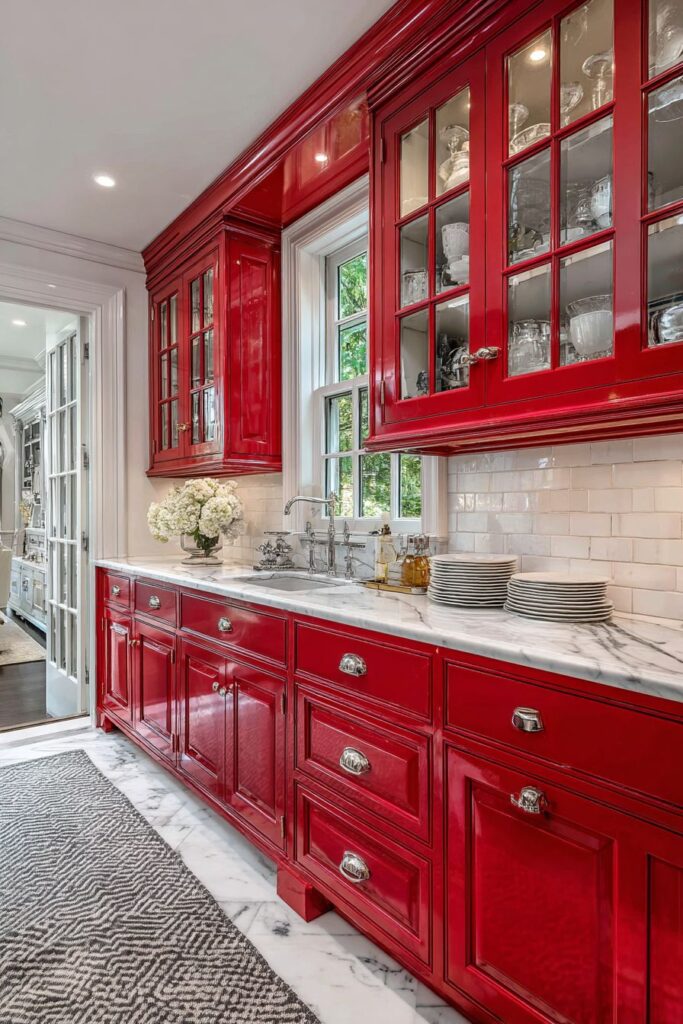
Key Design Tips:
- Use painted glass for cabinet doors to add color while maintaining visual lightness
- Balance transparent upper cabinets with solid lower cabinets for practical storage solutions
- Choose natural stone countertops that complement both colored and neutral elements
- Add texture through backsplash patterns and grout color choices
- Select hardware finishes that work with multiple color elements in the design
17. Red Reclaimed Wood Character
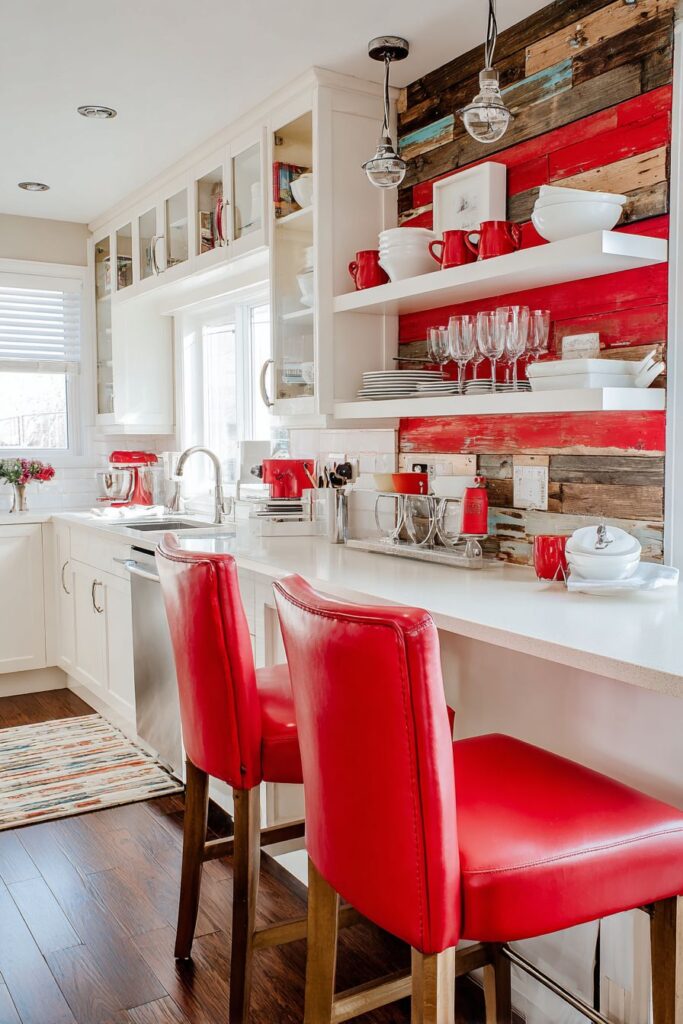
Embrace sustainable design and authentic character with this striking kitchen featuring a red reclaimed wood accent wall behind open shelving. This approach to wall treatment demonstrates how environmentally conscious choices can also be aesthetically stunning, the weathered wood bringing history and character that cannot be manufactured or replicated. The rich red stain enhances the natural grain patterns while adding vibrant color that energizes the entire space.
The open shelving displays white dishes and red pottery, creating a curated collection that feels both functional and decorative. This approach to display demonstrates how everyday items can become design elements when chosen and arranged thoughtfully. The contrast between the smooth ceramic pieces and the rough wood texture adds visual interest while maintaining color harmony throughout the composition.
White cabinets and stainless steel countertops keep the look fresh and contemporary while allowing the reclaimed wood to serve as the primary character element. The red leather bar stools add comfort and color continuity while introducing another natural material that complements the wood wall. Industrial-style light fixtures complete the design by adding contemporary edge while complementing the honest, unrefined character of the reclaimed materials.
Wide-angle photography captures the texture variations in the wood while showcasing the warm, inviting atmosphere created by this sustainable design choice. The interplay between rough and smooth textures, warm and cool tones, natural and manufactured materials creates a kitchen that feels both current and timeless. This design proves that environmental responsibility and stunning aesthetics can work hand in hand to create spaces that are both beautiful and meaningful.
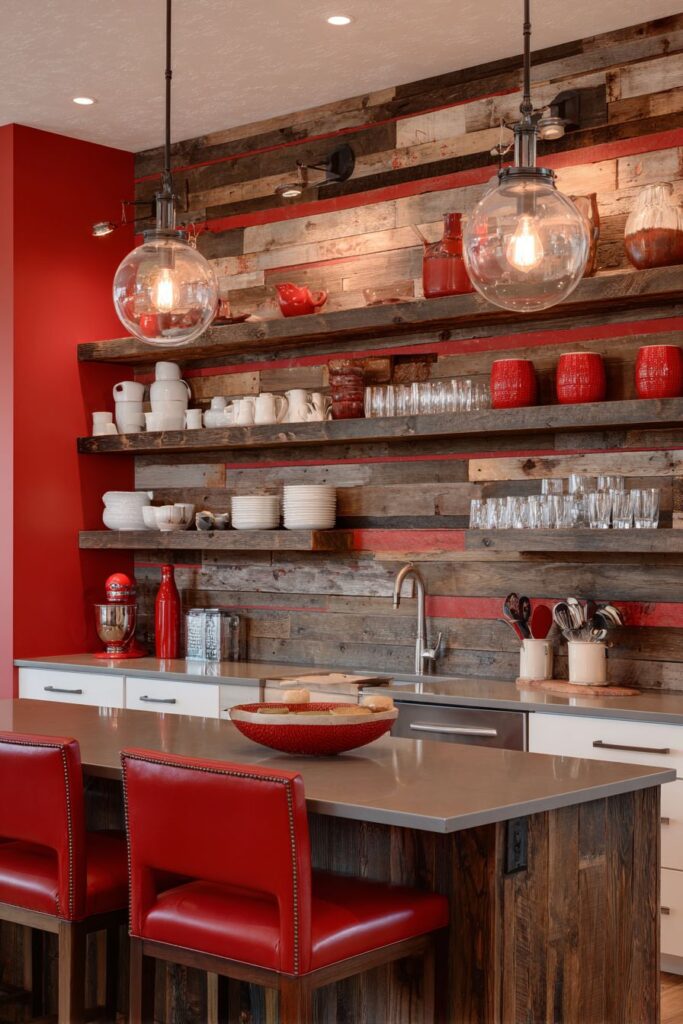
Key Design Tips:
- Source reclaimed wood with interesting grain patterns and authentic weathering for maximum character
- Stain reclaimed wood to enhance natural patterns while adding desired color
- Balance rustic wall treatments with contemporary cabinetry and appliances
- Use open shelving to display collections that complement the wood’s character
- Choose lighting fixtures that enhance rather than compete with natural material textures
18. Red Mosaic Artistry
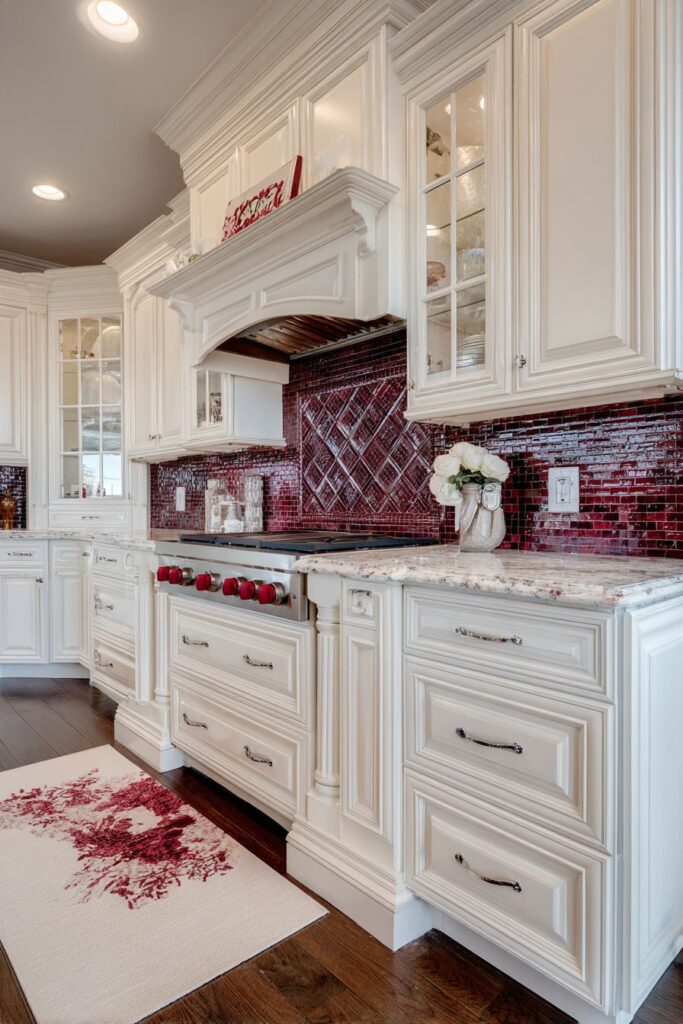
Create a kitchen masterpiece with this stunning red mosaic tile backsplash that showcases the incredible beauty possible when artisanal craftsmanship meets contemporary design. The varying shades from cherry to burgundy create depth and visual interest that changes throughout the day as light moves across the surface. This approach to backsplash design transforms a purely functional element into a work of art that serves as the kitchen’s focal point while providing practical protection for wall surfaces.
The white cabinets with red knobs and pulls echo the backsplash colors while maintaining visual balance throughout the space. This thoughtful approach to hardware selection demonstrates how small details can reinforce major design elements while adding another layer of color interest. The white marble countertops provide an elegant contrast while offering a neutral foundation that allows the intricate mosaic work to truly shine without competition.
The red kitchen runner protects the hardwood floor while adding another layer of color and texture to the overall design. This practical element demonstrates how textiles can be used to reinforce color stories while providing functional benefits like floor protection and comfort underfoot. The runner’s placement defines the primary workspace while adding visual warmth that complements the artisanal quality of the mosaic backsplash.
Professional interior photography with detailed focus captures the intricate mosaic pattern and color variations within the red tilework, showcasing the skill and artistry required to create such beautiful surfaces. The photographer’s attention to both overall composition and fine detail demonstrates how hand-crafted elements can elevate a kitchen from merely functional to truly spectacular. This design celebrates the beauty of traditional craftsmanship while meeting all the demands of contemporary kitchen use.
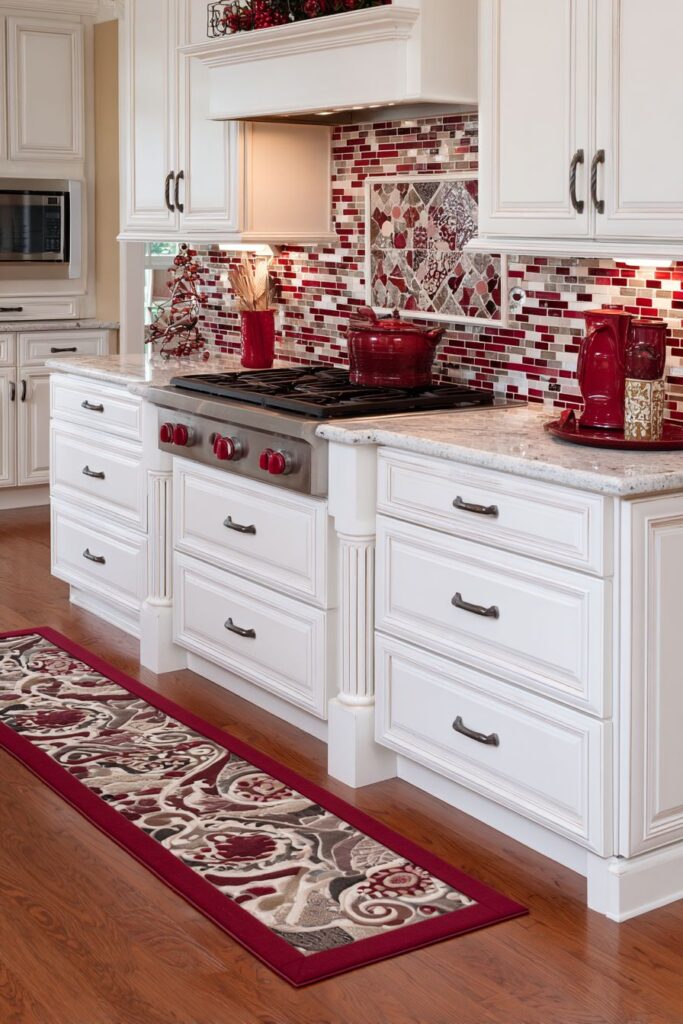
Key Design Tips:
- Choose mosaic tiles with subtle color variations for depth and visual interest
- Echo backsplash colors in cabinet hardware for design cohesion
- Use neutral countertops and cabinetry to showcase intricate mosaic work
- Add textiles like runners to reinforce color stories while providing practical benefits
- Plan lighting carefully to highlight the artisanal quality of hand-crafted tile work
19. Cottage Red Comfort
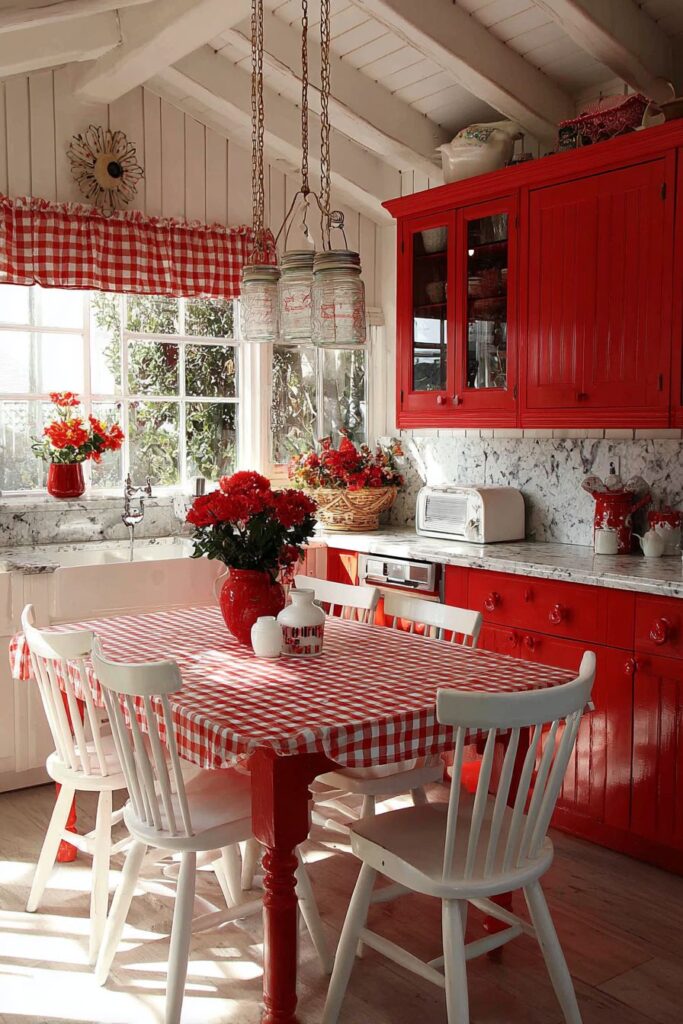
Embrace the charm and comfort of cottage living with this delightful red kitchen that celebrates the beauty of simple pleasures and authentic character. The red beadboard cabinet doors with vintage red knobs immediately establish the cottage aesthetic while adding texture and traditional detail that speaks to generations of country living. This approach to cabinetry demonstrates how traditional construction techniques and finishes can create spaces that feel both timeless and thoroughly current.
The white marble countertops and white farmhouse sink provide an elegant contrast while maintaining the clean, fresh appearance that defines cottage style. The red gingham window treatments add authentic country charm while filtering natural light in a way that enhances the cozy, lived-in atmosphere. The red painted kitchen table with white chairs creates a charming breakfast nook that serves as both a functional dining space and a decorative focal point.
Mason jar pendant lights add authentic rustic detail while providing warm, welcoming illumination that enhances the cottage atmosphere. The red flowers in white vases complete the aesthetic while bringing life and natural beauty into the space. These carefully chosen accessories demonstrate how authentic cottage style relies on genuine details rather than manufactured charm—every element serves a practical purpose while contributing to the overall design story.
Soft natural lighting emphasizes the cozy, lived-in feel and authentic cottage details throughout the space. The interplay between painted and natural finishes, warm and cool tones, rough and smooth textures creates a kitchen that feels like it has evolved naturally over time. This design proves that cottage style can be both sophisticated and comfortable, suitable for both daily family life and casual entertaining.
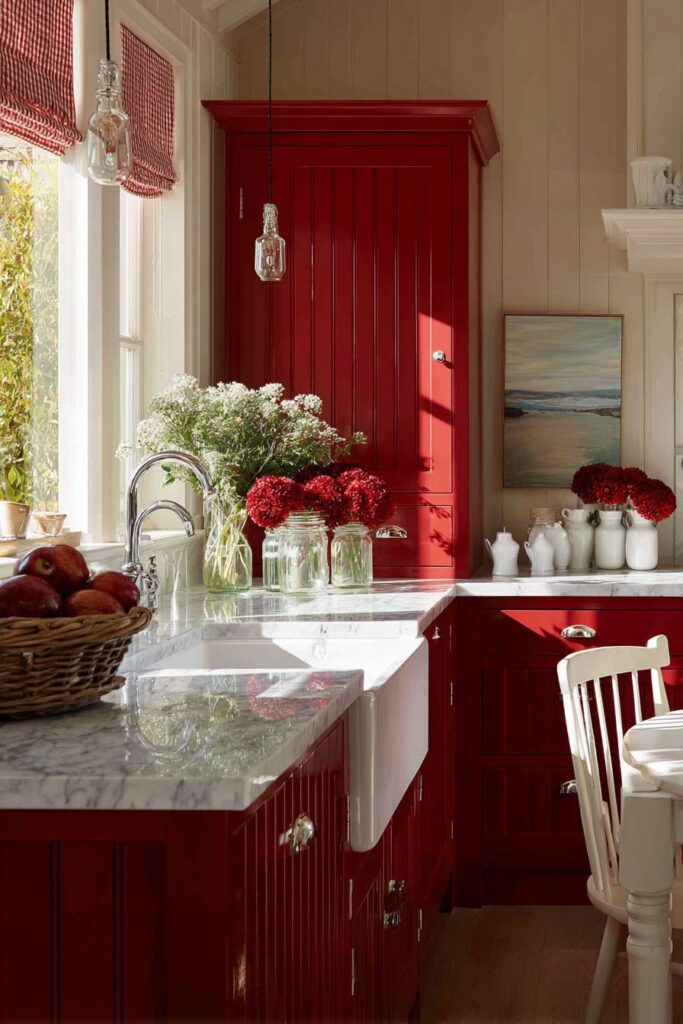
Key Design Tips:
- Use beadboard details and vintage hardware for authentic cottage character
- Incorporate traditional textiles like gingham for color and pattern
- Choose farmhouse sinks and marble countertops for practical elegance
- Add mason jar lighting and fresh flowers for genuine country charm
- Layer natural and painted finishes to create authentic, evolved character
20. Red Concrete Industrial Innovation
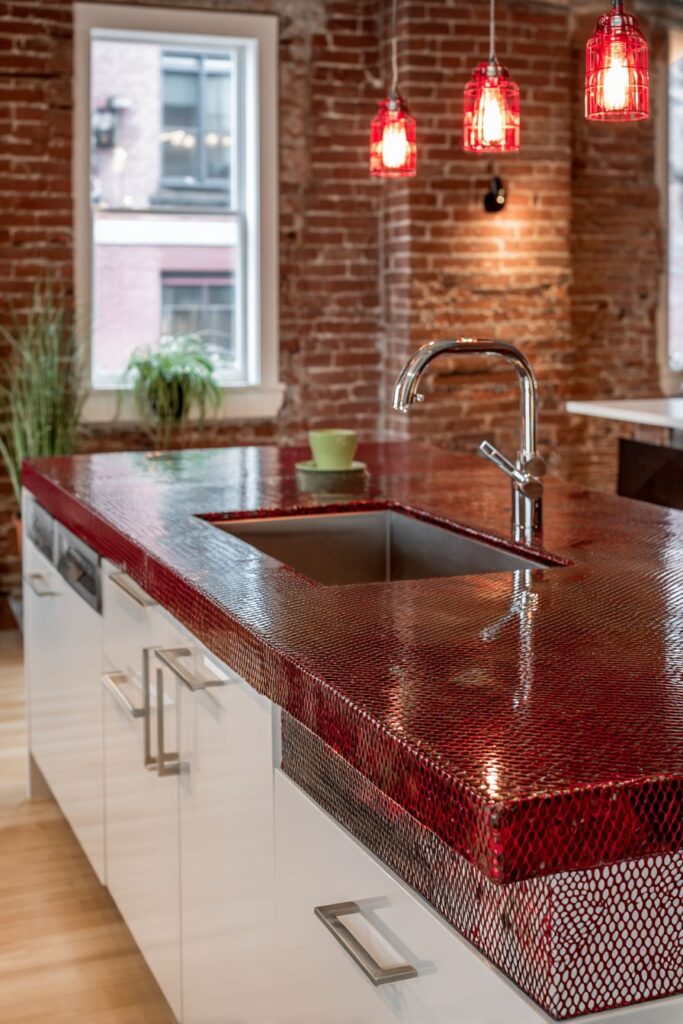
Push the boundaries of contemporary kitchen design with this innovative space featuring red concrete countertops with an integrated sink. This cutting-edge approach to surface materials demonstrates how industrial techniques can be adapted for residential use while creating unique, custom elements that cannot be found in any showroom. The seamless integration of sink and counter creates clean lines that epitomize modern design while showcasing the incredible versatility of concrete as a design material.
The white minimalist cabinets provide the perfect neutral foundation for this bold material choice, their simple forms and clean lines allowing the concrete work to take center stage. The red metal mesh cabinet inserts add industrial texture while maintaining functionality and visual interest. This innovative approach to cabinet door design demonstrates how traditional concepts can be reimagined using contemporary materials and techniques.
Red industrial pendant lights and an exposed red brick accent wall complete the urban loft aesthetic while reinforcing the color story established by the concrete surfaces. These elements work together to create a cohesive design narrative that celebrates the beauty of honest, unrefined materials while meeting all the functional demands of contemporary kitchen use. The brick wall adds texture and warmth while the pendant lights provide necessary task illumination.
Professional architectural photography captures the raw materials and bold color choice while highlighting the seamless integration of the red concrete surfaces. The photographer’s attention to both the craftsmanship details and the overall spatial composition demonstrates how innovative material choices can transform ordinary kitchens into extraordinary spaces. This design proves that industrial aesthetics can be both beautiful and livable when executed with skill and vision.
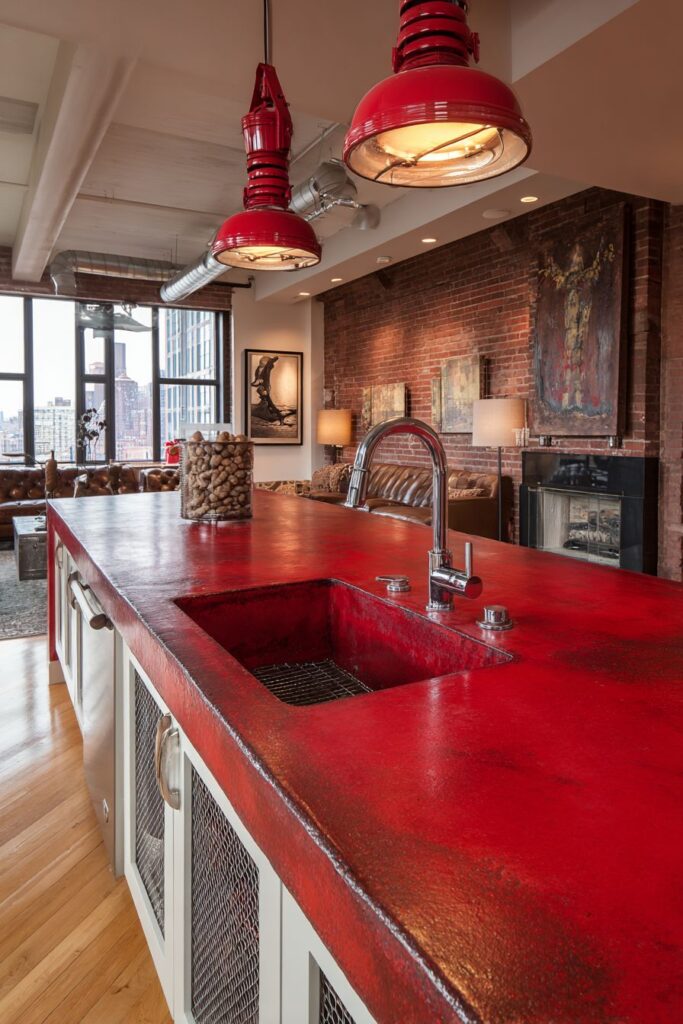
Key Design Tips:
- Work with skilled concrete artisans to achieve seamless integration of sinks and counters
- Use minimalist cabinetry to showcase bold material choices without competition
- Incorporate industrial details like metal mesh for authentic texture and character
- Choose pendant lighting that complements rather than competes with concrete surfaces
- Balance raw materials with refined details for sophisticated industrial appeal
Why These Red Kitchen Designs Are the Best
These twenty red kitchen designs represent the pinnacle of contemporary interior design thinking, each demonstrating unique approaches to incorporating this powerful color into functional, beautiful spaces. The modern cherry red lacquered elegance showcases how high-end materials and sophisticated color choices can create kitchens that serve as both functional workspaces and stunning focal points for entertaining. The seamless integration of glossy red cabinets with neutral elements proves that bold color can be both dramatic and livable when executed with professional skill and attention to detail.
The farmhouse burgundy charm demonstrates the enduring appeal of traditional aesthetics while proving that red can enhance rather than overwhelm classic design elements. This approach to color integration shows how distressed finishes and authentic materials can create spaces that feel both current and timeless, appealing to homeowners who value both character and functionality. The success of this design lies in its ability to feel genuine rather than manufactured, achieving authentic farmhouse appeal through careful attention to period-appropriate details and finishes.
Contemporary red accent drama proves that strategic color placement can transform entire spaces without requiring complete renovation. This sophisticated approach to kitchen design demonstrates how accent walls and coordinated lighting can create dramatic impact while maintaining practical functionality. The success of this design strategy makes it accessible to homeowners working with existing kitchens who want maximum impact from minimal intervention.
The small space red energy design addresses one of the most common challenges in contemporary living—creating character and personality in limited square footage. The innovative use of high-gloss finishes and strategic lighting demonstrates how thoughtful material selection can overcome spatial limitations while creating kitchens that feel both spacious and sophisticated. This approach proves that small kitchens need not sacrifice style for functionality when designed with skill and creativity.
Traditional red mahogany sophistication celebrates the enduring appeal of classic American design while demonstrating how traditional aesthetics can be adapted for contemporary living. The quality materials and authentic construction details create kitchens that improve with age while maintaining their relevance across changing design trends. This timeless approach to kitchen design offers lasting value and enduring beauty that transcends temporary fashion.
The red accessory accent mastery provides the most accessible approach to red kitchen design, demonstrating how careful curation and strategic placement can transform neutral spaces into dynamic, personality-filled environments. This approach appeals to homeowners who want flexibility and change options while maintaining sophisticated design impact. The success of this strategy lies in its adaptability—elements can be changed seasonally or as tastes evolve without major renovation.
Industrial red edge appeal showcases how urban aesthetics can be adapted for residential use while maintaining authenticity and character. The combination of exposed materials and bold color choices creates kitchens that feel both current and timeless, appealing to homeowners who appreciate honest materials and straightforward design approaches. This aesthetic demonstrates how industrial elements can create warmth and character when combined thoughtfully with residential comfort requirements.
The red marble statement luxury represents the ultimate in high-end kitchen design, showcasing how natural materials and expert craftsmanship can create spaces of unparalleled beauty and sophistication. This approach demonstrates how investment in quality materials pays dividends in both immediate impact and long-term value, creating kitchens that serve as true luxury amenities within the home.
Scandinavian red warmth proves that minimalist aesthetics can embrace bold color while maintaining the clean lines and functional beauty that define Nordic design. This approach appeals to homeowners who appreciate sophisticated restraint while wanting personality and warmth in their spaces. The success of this design lies in its ability to feel both thoroughly modern and deeply rooted in design tradition.
The red island focal point demonstrates how a single dramatic element can anchor entire kitchen designs while providing essential functionality. This approach to kitchen planning shows how strategic color placement can create hierarchy and visual flow while maximizing practical utility. The success of this design strategy makes it appealing to homeowners who want maximum impact from focused investment.
Each of these designs succeeds because it demonstrates fundamental principles of successful color integration: balance, proportion, quality materials, and attention to both functional and aesthetic requirements. They prove that red kitchen decor can be sophisticated, practical, and enduringly beautiful when approached with skill, creativity, and understanding of how color impacts both daily life and long-term satisfaction.
Conclusion
The journey through these twenty exceptional red kitchen designs reveals the incredible versatility and enduring appeal of this bold, passionate color in residential design. From the sleek sophistication of contemporary lacquered cabinets to the rustic charm of farmhouse distressed finishes, from the industrial edge of exposed brick walls to the luxury of natural marble surfaces, red proves itself capable of enhancing virtually any design aesthetic while maintaining its own distinct character and appeal.
These designs demonstrate that successful color integration requires more than simply choosing a favorite shade—it demands understanding of proportion, balance, material interaction, and the crucial relationship between color and light. Whether implemented as a dramatic focal point or subtle accent, through permanent architectural elements or easily changeable accessories, red kitchen decor offers homeowners the opportunity to create spaces that are both functionally superior and emotionally engaging.
The key to success with red kitchen decor lies in understanding your own lifestyle, aesthetic preferences, and long-term design goals. Some homeowners will gravitate toward the bold drama of floor-to-ceiling red elements, while others will prefer the flexibility and subtlety of accessory-based approaches. Both strategies can create stunning results when executed with attention to quality, proportion, and the fundamental principles of good design.
As you consider incorporating red into your own kitchen design, remember that the best choices are those that reflect your personality while enhancing your daily life. Whether you choose the timeless elegance of traditional raised-panel cabinets, the cutting-edge appeal of concrete surfaces, or the accessible charm of carefully curated accessories, let these inspiring examples guide you toward creating a kitchen that serves as both the functional heart of your home and a reflection of your unique style and vision.
